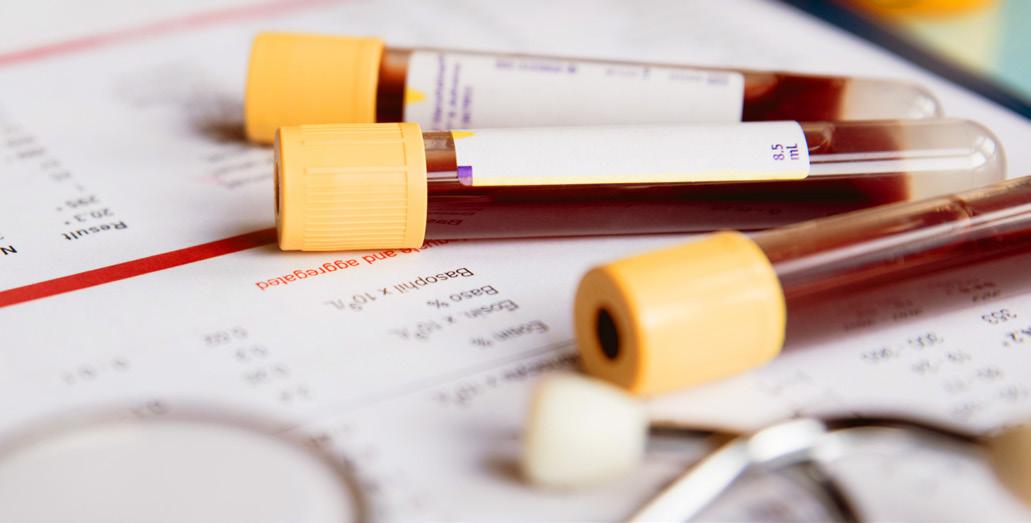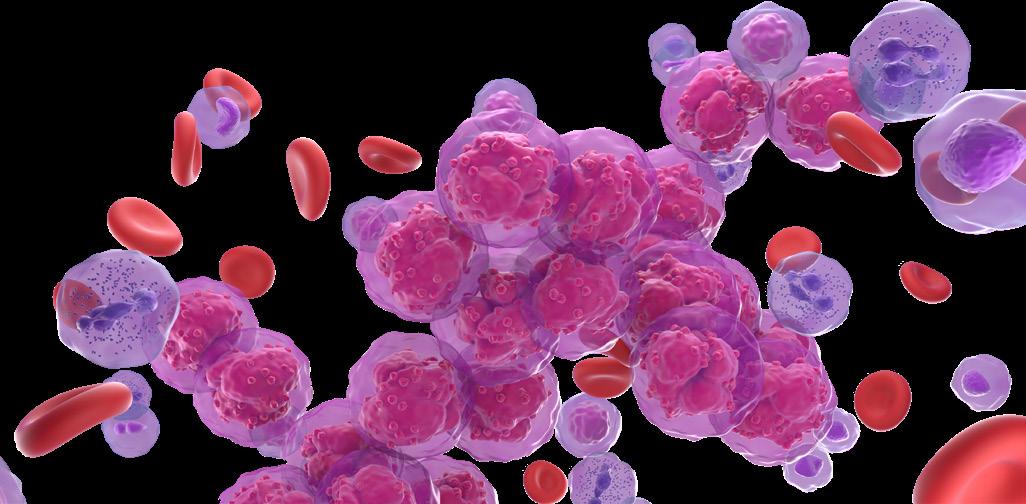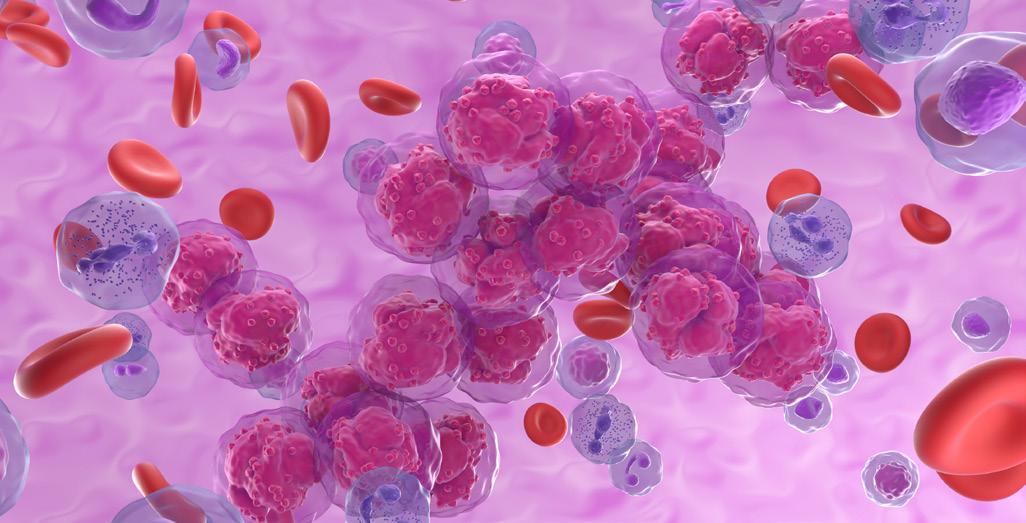




NEW LOOK. SAME TRUSTED PARTNERSHIP.
We’re delivering intelligently designed experiences that simplify health care. Join us in reimagining pharmacy solutions to provide the same care we would want for our loved ones.


Discover new Prime
Published By
Prime Therapeutics
2900 Ames Crossing Road Eagan, MN 55121 primetherapeutics.com
Editor
Lindsay Speicher, J.D. Project Manager, Specialty lindsay.speicher@primetherapeutics.com
Advertising, Sales and Distribution
Lindsay Speicher, J.D. lindsay.speicher@primetherapeutics.com
Joe Tavares joe.tavares@primetherapeutics.com
Contributors
Steve Cutts, PharmD
SVP, Specialty and Clinical Solutions
Haita Makanji, PharmD VP, Clinical Strategy and Innovation, Specialty
Amy E. Edquist Senior Manager, Marketing
Joe Tavares
SVP, Sales and Business Development, Specialty
Simone Ndujiuba, PharmD, BCOP Director, Clinical Strategy and Innovation, Oncology
Carole Kallas
Marketing Project Manager
Brian MacDonald, PharmD Director, Specialty Clinical Strategy and Innovation
Alina Young Associate Legal Counsel
Editorial Advisory Board
Mona M. Chitre, PharmD, CGP Chief Pharmacy Officer and President Pharmacy Solutions, Excellus Blue Cross Blue Shield
Dennis Bourdette, M.D., FAAN, FANA Chair and Roy and Eulalia Swank Family Research Professor, Department of Neurology, Oregon Health & Science University
Yousaf Ali, M.D., FACR Chief, Division of Rheumatology, Mount Sinai St. Luke's and Mount Sinai West; Professor of Medicine, Icahn School of Medicine at Mount Sinai
Steven L. D’Amato, B.S.Pharm. Founding Partner, Scientia Pharmacy Advisors
Joseph Mikhael, M.D., M.Ed., FRCPC, FACP Chief Medical Officer, International Myeloma Foundation
Steve Marciniak, RPh President, ClarityRX
Saira A. Jan, M.S., PharmD VP and Chief Pharmacy Officer, Horizon Blue Cross Blue Shield of New Jersey
4 Acute myeloid leukemia
15 Advanced melanoma: FIRST CELL THERAPY AND PAYER IMPACT
20 CAR T-cell therapy update: CHANGES, CHALLENGES AND MANAGEMENT STRATEGIES
Vorasidenib product spotlight 30 Oncology accelerated approval update: TRADITIONAL APPROVALS AND WITHDRAWALS
Oncology site of service: UPDATES IN FDA CLINICAL TRIAL GUIDELINES AND POTENTIAL IMPLICATIONS
Non-small cell lung cancer: MORE TARGETED TREATMENT APPROVALS AND PAYER IMPACT


Dear managed care colleagues,
Prime Therapeutics is excited to bring you our newly rebranded Prime Therapeutics Report, formerly the award-winning Magellan Rx Report. Ever since Prime and Magellan Rx united in December 2022, we’ve focused on creating a brighter future for our valued clients and their members. As part of this focus, we are unifying our brand under the Prime Therapeutics name with a new visual identity to encompass our collective strategies and ambitions. This change reflects our commitment to serving as a next-generation pharmacy solutions partner that’s reimagining pharmacy management to provide the same care we would want for our loved ones. While our name and brand are changing, we remain dedicated to bringing our readers valuable updates in managed care trends.
In our fall 2024 oncology issue, we focus on trends in oncology treatment and management. This issue’s cover story (Page 20) explores changes, challenges and management strategies in chimeric antigen receptor (CAR) T-cell therapy in the oncology space. In our advanced melanoma article (Page 15), we highlight the first approved tumor-infiltrating lymphocyte (TIL) treatment for cancer. Given this exciting new approval in the advanced melanoma space, we discuss key points payers should consider when identifying the appropriate patients and places they should be treated.
We turn our focus to updates in the acute myeloid leukemia (AML) space (Page 4), including a new approval that offers more options for patients with AML who have a specific gene mutation. Advances in oral therapies and outpatient treatments mean payers and patients may both have significant opportunities.
Finally, we discuss other oncology topics in this issue, including site of service (Page 44), accelerated approvals (Page 30), non-small cell lung cancer (Page 50) and a product spotlight on vorasidenib (Page 40). We round out the issue with information on the oncology drug pipeline (Page 58). To learn more about how we’re supporting transformative payer initiatives, please feel free to contact us at PTReport@primetherapeutics.com. As always, we value any feedback you may have. Enjoy the report!
Sincerely,

Steve Cutts, PharmD Senior Vice President, Specialty and Clinical Solutions Prime Therapeutics


Michael Ochowski, PharmD
Pharmacy Informatics & EMR Support
Group Health
Cooperative of South Central Wisconsin
Acute myeloid leukemia (AML) is a highly aggressive type of cancer that occurs when bone marrow produces a large number of abnormal cells. This type of blood cancer results from clonal expansion of myeloid hematopoietic precursors in bone marrow.1 Circulating leukemia cells, or blasts, are present in the peripheral blood, and granulocytopenia, anemia and thrombocytopenia are also common, since proliferating blasts interfere with normal hematopoiesis.1
AML is the most common form of acute leukemia among adults, accounting for the largest number of annual deaths from leukemias in the U.S.2 In 2024, an estimated 20,800 individuals will be diagnosed with AML, and the disease will be associated with an estimated 11,220 deaths.2 Diagnosis before the age of 45 is uncommon; more than 60% of patients are diagnosed at age 65 or older, and the median age at diagnosis is 68 years.1, 3
AML symptoms often arise over a four-to-six week period prior to diagnosis.1 AML may present with symptoms including weakness, fever, infection, pallor and bleeding.1 Other symptoms and complications may result from the hampered production of normal blood cells due to leukemic infiltration of the bone marrow.1 Less commonly, patients may present with symptoms related to the collection of leukemia cells in different areas of the body, which may take the form of central nervous system or testicular involvement or that of myeloid sarcoma.1
Recent advances in AML treatment have improved complete remission (CR) rates: approximately 60% to 70% of adults with AML are expected to attain CR status after appropriate induction therapy.1 About 45% of patients who attain CR, representing 25% of adults with AML, are estimated to survive three or more years.1
AML is the most common form of acute leukemia among adults, accounting for the largest number of annual deaths from leukemias in the U.S.
About half of patients with AML have chromosomal abnormalities, and identifying genetic mutations is important to determining treatment and prognosis.1 Some genetic mutations associated with AML are NPM1, FLT3, CEPBA and RUNX1. 1
Specifically, the prevalence of FLT3 mutations is high among patients with AML. Patients with this mutation experience
lower survival rates and escalated probability of relapse.4 At diagnosis, FLT3 mutations screenings are standard — and even mandatory — and targeting these mutations where present is critical to treating AML.4 FLT3 mutations have two categories: FLT3-ITD, the most common category, affects nearly 25% of AML patients, and FLT3-TKD affects 6% to 8%.4
The U.S. Food and Drug Administration’s (FDA) 2017 midostaurin (Rydapt®) approval marked the first approval of a targeted therapy to treat patients with AML.5 Midostaurin was indicated for adult patients with newly diagnosed AML who have the FLT3 mutation.5 This targeted therapy, along with the earlier use of stem cell transplants, helped improve outcomes for patients with AML and FLT3 mutations.6
However, thanks to a new approval designed to specifically address the FLT3-ITD mutation, patients with AML have more options for potentially improving survival.6
In July 2023, the FDA approved quizartinib (Vanflyta, Daiichi Sankyo) with standard cytarabine and anthracycline induction and cytarabine consolidation for the treatment of adult patients with newly diagnosed

AML that is FLT3-ITD-positive, as detected by an FDAapproved test.7 Simultaneously, the LeukoStrat® CDx FLT3 Mutation Assay was approved by the FDA as a companion diagnostic for quizartinib.7
The QuANTUM-First randomized, double-blind, placebocontrolled trial evaluated efficacy of quizartinib with chemotherapy.8 The trial included 539 patients with newly diagnosed FLT3-ITD-positive AML, determined prospectively with a clinical trial assay and verified retrospectively with the companion diagnostic assay.8 Trial participants were randomized 1:1 to receive quizartinib or placebo with induction and consolidation therapy and as maintenance monotherapy according to initial assignment.8 Overall survival (OS) was the main efficacy outcome and the primary analysis was conducted after a minimum follow-up of 24 months after the last patient was randomized. The quizartinib arm achieved a statistically significant improvement in OS; the CR rate in the quizartinib arm was 55% with a median duration of 38.6 months, compared to a median duration of 12.4 months in the placebo arm.8
Quizartinib includes a boxed warning, which notes QT prolongation, torsade de pointes and cardiac arrest.7 It is available only through a restricted program under a Risk Evaluation and Mitigation Strategy (REMS).7 The treatment
is not indicated as maintenance monotherapy following allogeneic hematopoietic stem cell transplantation (HSCT).7
While midostaurin can be used in AML patients with FLT3-ITD or FLT3-TKD, some AML specialists opine that oncologists may utilize quizartinib as the preferred initial treatment in patients with FLT3-ITD mutations.6 Notably, according to Dr. Harry Erba of the Duke Cancer Institute, when patients with the FLT3-ITD mutation experience a relapse, it is often due to the development of the FLT3-TKD mutation.6 Thus, providers should utilize quizartinib first and reserve gilteritinib, which is indicated as a second-line treatment, for relapses caused by TKD mutations.6
The FDA approved omidubicel-onlv (Omisirge, Gamida Cell Ltd.) in April 2023.9 Omidubicel is a substantially modified allogeneic (donor) cord blood-based cell therapy intended to quicken the recovery of neutrophils in the body and reduce the risk of infection.9 It is indicated for use in adults and pediatric patients 12 years and older who have blood cancers planned for umbilical cord blood transplantation following a myeloablative conditioning



regimen, such as radiation or chemotherapy.9 Omidubicel is administered as a single, patient-specific intravenous dose containing healthy stem cells from an allogeneic pre-screened donor.9
A randomized multicenter study evaluated this treatment’s safety and effectiveness, comparing transplantation of omidubicel to transplantation of umbilical cord blood in subjects between the ages of 13 and 65 years.10 A total of 125 subjects with confirmed blood cancers participated in the study, and efficacy was based on the time necessary to recover the subject’s neutrophils and the incidence of infections following transplantation.10 Of those randomized to receive omidubicel, 87% achieved neutrophil recovery with a median of 12 days following treatment, compared to 83% of those who received umbilical cord blood transplantation and achieved neutrophil recovery in 22 days.10 About 39% of subjects who received omidubicel experienced bacterial or fungal infections by 100 days following transplantation, compared to 60% of those who received umbilical cord blood.10
Treatment with omidubicel is associated with the risk of severe side effects — the label carries a boxed warning for infusion reactions, graft-versus-host disease (GvHD), engraftment syndrome and graft failure.9 Adverse reactions associated with omidubicel include infections, GvHD,
transmission of serious infections or rare genetic disease from donor cells and lifelong risk of secondary malignancies.9
The economic burden associated with AML treatment and supportive care is significant.11, 12 AML comes with high health care costs and extensive health care utilization, including frequent outpatient visits, numerous hospitalizations and multiple red blood cell and platelet transfusions, as well as other supportive care services.11, 12 Studies have shown that the primary driver of medical costs in the AML population is inpatient hospitalization.11, 12
Advances in oral and outpatient therapies could potentially lead to reduced costs; however, the overall economic burden associated with AML will likely increase as more patients become eligible for novel therapies across the various stages of the disease.13 This will require payers to determine coverage strategies for longer and more complex AML treatment journeys.13 Some strategies may include encouraging oral and self-administered therapies and outpatient care when feasible.13 Because hospitalization is a major cost driver for AML, effective treatment regimens that prevent unplanned inpatient hospitalization may be critical to mitigating costs.11, 13
1. Acute Myeloid Leukemia Treatment (PDQ®) - Health Professional Version. (2024, March 6). National Cancer Institute. https://www.cancer.gov/types/leukemia/hp/ adult-aml-treatment-pdq
2. Cancer Facts & Figures 2024. (2024). American Cancer Society. https://www.cancer.org/research/cancerfacts-statistics/all-cancer-facts-figures/2024-cancerfacts-figures.html
3. Cancer Stat Facts: Leukemia. National Cancer Institute. Retrieved April 23, 2024, from https://seer.cancer.gov/ statfacts/html/leuks.html
4. Negotei, C., et al. (2023). A Review of FLT3 Kinase Inhibitors in AML. Journal of Clinical Medicine, 12(20), 6429. https://doi.org/10.3390/jcm12206429
5. FDA approves new combination treatment for acute myeloid leukemia. (2017, April 28). U.S. Food and Drug Administration. https://www.fda.gov/newsevents/press-announcements/fda-approves-newcombination-treatment-acute-myeloid-leukemia
6. Phillips, C. (2023, Aug. 15). Quizartinib Approval Adds New Treatment Option for AML, Including in Older Patients. National Cancer Institute. https://www.cancer. gov/news-events/cancer-currents-blog/2023/fdavanflyta-aml-flt3
7. FDA approves quizartinib for newly diagnosed acute myelod leukemia. (2023, July 20). U.S. Food and Drug Administration. https://www.fda.gov/drugs/drugapprovals-and-databases/fda-approves-quizartinibnewly-diagnosed-acute-myeloid-leukemia
8. Erba, H.P., et al. (2023). Quizartinib plus chemotherapy in newly diagnosed patients with FLT3-internaltandem-duplication-positive acute myeloid leukaemia (QuANTUM-First): a randomised, doubleblind, placebo-controlled, phase 3 trial. Lancet, 401(10388), 1571–1583. hhttps://doi.org/10.1016/s01406736(23)00464-6
9. FDA approves omidubicel to reduce time to neutrophil recovery and infection in patients with hematologic malignancies. (2023, April 17). U.S. Food and Drug Administration. https://www.fda.gov/drugs/resourcesinformation-approved-drugs/fda-approvesomidubicel-reduce-time-neutrophil-recovery-andinfection-patients-hematologic
10. Horwitz, M.E., et al. (2021). Omidubicel vs standard myeloablative umbilical cord blood transplantation: results of a phase 3 randomized study. Blood, 138(16), 1429–1440. https://doi.org/10.1182/blood.2021011719
11. Updates and Evolving Treatment Strategies in Acute Myeloid Leukemia. (2022, Aug. 8). American Journal of Managed Care. https://www.ajmc.com/view/updatesand-evolving-treatment-strategies-in-acute-myeloidleukemia
12. Bell J.A., Galaznik A., et al. (2018). Economic burden of elderly patients with acute myeloid leukemia treated in routine clinical care in the United States. Leukemia Research, 71, 27–33. https://doi.org/10.1016/j. leukres.2018.06.010
13. Forsythe, A., et al. (2021). What Does the Economic Burden of Acute Myeloid Leukemia Treatment Look Like for the Next Decade? An Analysis of Key Findings, Challenges and Recommendations. Journal of Blood Medicine, 12, 245–255. https://doi.org/10.2147/jbm. s279736






















































Find the complete guidelines at NCCN.org or visit
WARNING: QT PROLONGATION, TORSADES DE POINTES, and CARDIAC ARREST
• VANFLYTA® (quizartinib) prolongs the QT interval in a dose- and concentration-related manner. Prior to VANFLYTA administration and periodically, monitor for hypokalemia or hypomagnesemia, and correct deficiencies. Perform electrocardiograms (ECGs) to monitor the QTc at baseline, weekly during induction and consolidation therapy, weekly for at least the first month of maintenance, and periodically thereafter.
• Torsades de pointes and cardiac arrest have occurred in patients receiving VANFLYTA. Do not administer VANFLYTA to patients with severe hypokalemia, severe hypomagnesemia, or long QT syndrome.
• Do not initiate treatment with VANFLYTA or escalate the VANFLYTA dose if the QT interval corrected by Fridericia’s formula (QTcF) is greater than 450 ms.
• Monitor ECGs more frequently if concomitant use of drugs known to prolong the QT interval is required.

• Reduce the VANFLYTA dose when used concomitantly with strong CYP3A inhibitors, as they may increase quizartinib exposure.
• Because of the risk of QT prolongation, VANFLYTA is available only through a restricted program under a Risk Evaluation and Mitigation Strategy (REMS) called the VANFLYTA REMS.
VANFLYTA is indicated in combination with standard cytarabine and anthracycline induction and cytarabine consolidation, and as maintenance monotherapy following consolidation chemotherapy, for the treatment of adult patients with newly diagnosed acute myeloid leukemia (AML) that is FLT3 internal tandem duplication (ITD)–positive as detected by an FDA-approved test.
Limitations of Use:
Please see Brief PI Summary, including Boxed WARNINGS.

VANFLYTA is not indicated as maintenance monotherapy following allogeneic hematopoietic stem cell transplantation (HSCT); improvement in overall survival with VANFLYTA in this setting has not been demonstrated.
FLT3=FMS-like tyrosine kinase 3; ITD=internal tandem duplication; NCCN=National Comprehensive Cancer Network. Reference: Referenced with permission from the NCCN Clinical Practice Guidelines in Oncology (NCCN Guidelines®) for Acute Myeloid Leukemia V.2.2024. © National Comprehensive Cancer Network, Inc. 2024. All rights reserved. Accessed April 26, 2024. To view the most recent and complete version of the guideline, go online to NCCN.org. NCCN makes no warranties of any kind whatsoever regarding their content, use or application and disclaims any responsibility for their application or use in any way.





VANFLYTA® (quizartinib) tablets, for oral use
Initial U.S. Approval: 2023
BRIEF SUMMARY: Please see package insert for full prescribing information.
• VANFLYTA prolongs the QT interval in a dose- and concentration-related manner [see Clinical Pharmacology (12.2) in the full prescribing information]. Prior to VANFLYTA administration and periodically, monitor for hypokalemia or hypomagnesemia, and correct deficiencies. Perform ECGs to monitor the QTc at baseline, weekly during induction and consolidation therapy, weekly for at least the first month of maintenance, and periodically thereafter [see Dosage and Administration (2.3) in the full prescribing information and Warnings and Precautions (5.1)].
• Torsades de pointes and cardiac arrest have occurred in patients receiving VANFLYTA. Do not administer VANFLYTA to patients with severe hypokalemia, severe hypomagnesemia, or long QT syndrome [see Contraindications (4) and Warnings and Precautions (5.1)]
• Do not initiate treatment with VANFLYTA or escalate the VANFLYTA dose if the QT interval corrected by Fridericia’s formula (QTcF) is greater than 450 ms [see Dosage and Administration (2.3) in the full prescribing information and Warnings and Precautions (5.1)]
• Monitor ECGs more frequently if concomitant use of drugs known to prolong the QT interval is required [see Dosage and Administration (2.3) in the full prescribing information and Warnings and Precautions (5.1)]
• Reduce the VANFLYTA dose when used concomitantly with strong CYP3A inhibitors, as they may increase quizartinib exposure [see Dosage and Administration (2.4) in the full prescribing information and Warnings and Precautions (5.1)].
• Because of the risk of QT prolongation, VANFLYTA is available only through a restricted program under a Risk Evaluation and Mitigation Strategy (REMS) called the VANFLYTA REMS [see Warnings and Precautions (5.2)].
1 INDICATIONS AND USAGE
VANFLYTA is indicated in combination with standard cytarabine and anthracycline induction and cytarabine consolidation, and as maintenance monotherapy following consolidation chemotherapy, for the treatment of adult patients with newly diagnosed acute myeloid leukemia (AML) that is FLT3 internal tandem duplication (ITD)-positive as detected by an FDAapproved test [see Dosage and Administration (2.1) and Clinical Studies (14) in the full prescribing information]
Limitations of Use
VANFLYTA is not indicated as maintenance monotherapy following allogeneic hematopoietic stem cell transplantation (HSCT); improvement in overall survival with VANFLYTA in this setting has not been demonstrated [see Clinical Studies (14) in the full prescribing information].
4 CONTRAINDICATIONS
VANFLYTA is contraindicated in patients with severe hypokalemia, severe hypomagnesemia, long QT syndrome, or in patients with a history of ventricular arrhythmias or torsades de pointes [see Warnings and Precautions (5.1)]
5 WARNINGS AND PRECAUTIONS
5.1 QT Prolongation, Torsades de Pointes, and Cardiac Arrest
VANFLYTA prolongs the QT interval in a dose- and concentration-dependent manner. The mechanism of QTc interval prolongation is via inhibition of the slow delayed rectifier potassium current, IKs, as compared to all other medications that prolong the QTc interval, which is via the rapid delayed rectifier potassium current, IKr. Therefore, the level of QTc prolongation with VANFLYTA that predicts the risk of cardiac arrhythmias is unclear. Inhibition of IKs and IKr may leave patients with limited reserve leading to a higher risk of QT prolongation and serious cardiac arrhythmias, including fatal outcomes [see Clinical Pharmacology (12.2) in the full prescribing information] Torsades de pointes, ventricular fibrillation, cardiac arrest, and sudden death have occurred in patients treated with VANFLYTA.
Of the 1,081 patients with AML treated with VANFLYTA in clinical trials, torsades de pointes occurred in approximately 0.2% of patients, cardiac arrest occurred in 0.6%, including 0.4% with a fatal outcome, and 0.1% of patients experienced ventricular fibrillation [see Adverse Reactions (6.1)] These severe cardiac arrhythmias occurred predominantly during the induction phase.
Of the 265 patients with newly diagnosed FLT3-ITD-positive AML treated with VANFLYTA in combination with chemotherapy in the clinical trial, 2.3% were found to have a QTcF greater than 500 ms and 10% of patients had an increase from baseline QTcF greater than 60 ms. The clinical trial excluded patients with a QTcF ≥450 ms or other factors that increased the risk of QT prolongation or arrhythmic events (e.g., NYHA Class III or IV
congestive heart failure, hypokalemia, family history of long QT interval syndrome). Therefore, avoid use in patients who are at significant risk of developing torsades de pointes, including uncontrolled or significant cardiac disease, recent myocardial infarction, heart failure, unstable angina, bradyarrhythmias, tachyarrhythmias, uncontrolled hypertension, highdegree atrioventricular block, severe aortic stenosis, or uncontrolled hypothyroidism.
Do not initiate treatment with VANFLYTA if the QTcF interval is greater than 450 ms. Do not use VANFLYTA in patients with severe hypokalemia, severe hypomagnesemia, long QT syndrome, or in patients with a history of ventricular arrhythmias or torsades de pointes [see Contraindications (4)]
Perform an ECG and correct electrolyte abnormalities prior to initiation of treatment with VANFLYTA. During induction and consolidation, perform an ECG prior to initiation and then once weekly during VANFLYTA treatment or more frequently as clinically indicated. During maintenance, perform ECGs prior to initiation, once weekly for at least the first month following dose initiation and escalation, and as clinically indicated thereafter. Do not escalate the dose if QTcF is greater than 450 ms [see Dosage and Administration (2.3) in the full prescribing information]
Perform ECG monitoring of the QT interval more frequently in patients who are at significant risk of developing QT interval prolongation and torsades de pointes, or following dose escalation.
Monitor and correct hypokalemia and hypomagnesemia prior to and during treatment with VANFLYTA. Maintain electrolytes in the normal range. Monitor electrolytes and ECGs more frequently in patients who experience diarrhea or vomiting.
Monitor patients more frequently with ECGs if coadministration of VANFLYTA with drugs known to prolong the QT interval is required [see Drug Interactions (7)]
Reduce the VANFLYTA dose when used concomitantly with strong CYP3A inhibitors, as they may increase quizartinib exposure [see Dosage and Administration (2.4) in the full prescribing information]
Reduce VANFLYTA if QTc increases to greater than 480 ms and less than 500 ms. Interrupt and reduce VANFLYTA if QTc increases to greater than 500 ms. Permanently discontinue VANFLYTA in patients who develop recurrent QTc greater than 500 ms or QTc interval prolongation with signs or symptoms of life-threatening arrhythmia [see Dosage and Administration (2.3) in the full prescribing information]
VANFLYTA is available only through a restricted program under a REMS [see Warnings and Precautions (5.2)].
5.2 VANFLYTA REMS
VANFLYTA is available only through a restricted distribution program under a REMS called the VANFLYTA REMS because of the serious risk of QT prolongation, torsades de pointes, and cardiac arrest [see Warnings and Precautions (5.1)]
Notable requirements of the VANFLYTA REMS include the following:
• Prescribers must be certified in the VANFLYTA REMS by enrolling and completing training.
• Prescribers must counsel patients receiving VANFLYTA about the risk of QT prolongation, torsades de pointes, and cardiac arrest, and provide patients with a Patient Wallet Card.
• Pharmacies that dispense VANFLYTA must be certified with the VANFLYTA REMS and must verify prescribers are certified through the VANFLYTA REMS.
Further information about the VANFLYTA REMS is available at www.VANFLYTAREMS.com or by telephone at 1-855-212-6670.
5.3 Embryo-Fetal Toxicity
Based on findings in animals and its mechanism of action, VANFLYTA can cause fetal harm when administered to a pregnant woman. In animal reproduction studies, administration of quizartinib to pregnant rats during organogenesis at exposures 3 times the maximum recommended human dose (MRHD) of 53 mg/day caused structural abnormalities and alterations to growth.
Advise pregnant women of the potential risk to a fetus. Advise females of reproductive potential to use effective contraception during treatment with VANFLYTA and for 7 months after the last dose. Advise males with female partners of reproductive potential to use effective contraception during treatment with VANFLYTA and for 4 months after the last dose [see Use in Specific Populations (8.1, 8.3)]
6 ADVERSE REACTIONS
The following clinically significant adverse reactions are described elsewhere in the labeling:
• QT Prolongation, Torsades de Pointes, and Cardiac Arrest [see Warnings and Precautions (5.1)]
Because clinical trials are conducted under widely varying conditions, adverse reaction rates observed in the clinical trials of a drug cannot be directly compared to rates in the clinical trials of another drug and may not reflect the rates observed in practice.
The safety of VANFLYTA (35.4 mg orally once daily with chemotherapy, 26.5 mg to 53 mg orally once daily as maintenance) in adult patients with newly diagnosed FLT3-ITD positive AML is based on QuANTUM-First, a randomized, double-blind clinical trial of VANFLYTA (n=265) or placebo (n=268) with chemotherapy [see Clinical Studies (14) in the full prescribing information]. Among patients who received VANFLYTA, 38% were exposed for 6 months or longer and 30% were exposed for greater than one year. On the VANFLYTA plus chemotherapy arm, 65% and 44% of patients completed induction and consolidation therapy, respectively, compared to 65% and 34% of patients in the placebo plus chemotherapy arm.
Serious adverse reactions in ≥5% of patients who received VANFLYTA plus chemotherapy were: febrile neutropenia (11%). Fatal adverse reactions occurred in 10% of patients who received VANFLYTA plus chemotherapy, including sepsis (5%), fungal infections (0.8%), brain edema (0.8%), and one case each of febrile neutropenia, pneumonia, cerebral infarction, acute respiratory distress syndrome, pulmonary embolism, ventricular dysfunction, and cardiac arrest.
Permanent discontinuation due to an adverse reaction in patients in the VANFLYTA plus chemotherapy arm occurred in 20% of patients. The most frequent (≥2%) adverse reaction which resulted in permanent discontinuation in the VANFLYTA arm was sepsis (5%).
Dosage interruptions of VANFLYTA due to an adverse reaction occurred in 34% of patients. Adverse reactions which required dosage interruption in ≥2% of patients in the VANFLYTA arm included neutropenia (11%), thrombocytopenia (5%), and myelosuppression (3%).
Dose reductions of VANFLYTA due to an adverse reaction occurred in 19% of patients. Adverse reactions which required dosage reductions in ≥2% of patients in the VANFLYTA arm were neutropenia (9%), thrombocytopenia (5%), and electrocardiogram QT prolonged (4%).
The most common adverse reactions (≥10% with a difference between arms of ≥2% compared to placebo), including laboratory abnormalities, were lymphocytes decreased, potassium decreased, albumin decreased, phosphorus decreased, alkaline phosphatase increased, magnesium decreased, febrile neutropenia, diarrhea, mucositis, nausea, calcium decreased, abdominal pain, sepsis, neutropenia, headache, creatine phosphokinase increased, vomiting, upper respiratory tract infections, hypertransaminasemia, thrombocytopenia, decreased appetite, fungal infections, epistaxis, potassium increased, herpesvirus infections, insomnia, electrocardiogram QT prolonged, magnesium increased, sodium increased, dyspepsia, anemia, and eye irritation.
Tables 5 and 6 summarize adverse reactions and laboratory abnormalities observed in patients receiving VANFLYTA in the clinical trial.
Table 5: Adverse Reactions (≥10%) in Patients with Newly Diagnosed FLT3-ITD positive AML Who Received VANFLYTA (with a Difference Between Arms of ≥2% Compared to Placebo) in the Clinical Trial
Body System
Adverse Reaction VANFLYTA + Chemotherapy (N=265)
Grade 3 or 4
Blood and Lymphatic System Disorders
Febrile
Neutropenia†
Gastrointestinal Disorders
Table 5: Adverse Reactions (≥10%) in Patients with
Body System
* Including fatalities.
† Includes other related terms.
a Diarrhea includes colitis, diarrhea, enteritis, enterocolitis, gastroenteritis, and neutropenic colitis.
b Mucositis includes anal inflammation, anal ulcer, anorectal discomfort, aphthous ulcer, laryngeal inflammation, laryngeal pain, mucosal inflammation, edema mucosal, esophageal pain, esophageal ulcer, esophagitis, oral blood blister, oral disorder, oral mucosa erosion, oral mucosal blistering, oral mucosal erythema, oral pain, oropharyngeal pain, pharyngeal inflammation, proctalgia, proctitis, stomatitis, tongue ulceration, and vaginal ulceration.
c Sepsis includes acinetobacter infection, bacteremia, bacterial sepsis, corynebacterium bacteremia, device related bacteremia, device related sepsis, enterobacter sepsis, enterococcal bacteremia, enterococcal sepsis, escherichia bacteremia, escherichia sepsis, klebsiella bacteremia, klebsiella sepsis, neutropenic sepsis, pseudomonal bacteremia, pulmonary sepsis, sepsis, septic shock, staphylococcal bacteremia, staphylococcal infection, staphylococcal sepsis, stenotrophomonas sepsis, streptococcal sepsis, and streptococcal bacteremia.
d Fungal infection includes aspergillosis oral, aspergillus infection, bronchopulmonary aspergillosis, candida infection, candida sepsis, fungal infection, fungal sepsis, fungal skin infection, fusarium infection, gastrointestinal candidiasis, hepatic infection fungal, hepatosplenic candidiasis, lower respiratory tract infection fungal, mucormycosis, oral candidiasis, oral fungal infection, oropharyngeal candidiasis, systemic candida, systemic mycosis, tinea cruris, and vulvovaginal candidiasis.
e Herpesvirus infection includes disseminated varicella zoster virus infection, genital herpes, herpes simplex, herpesvirus infection, herpes zoster, oral herpes, and varicella zoster virus infection.
f Hypertransaminasemia includes alanine aminotransferase increased, aspartate aminotransferase increased, transaminases increased, hepatic enzymes increased, and hypertransaminasemia.
g Eye irritation includes dry eye, eye inflammation, eye irritation, eye pain, eye pruritus, foreign body sensation in eyes, keratitis, and ulcerative keratitis.
Laboratory Abnormalities
Prolonged thrombocytopenia or neutropenia in the absence of active leukemia lasting past cycle day 42 of induction cycle 1 were noted in 8% of patients on the VANFLYTA plus chemotherapy arm and 4% of patients in the placebo plus chemotherapy arm.
Table 6: Select Laboratory Abnormalities (≥10%) That Worsened from Baseline in Patients with Newly Diagnosed FLT3-ITD positive AML (with a Difference Between Arms of ≥2% Compared to Placebo) in the Clinical Trial
Laboratory Abnormality
VANFLYTA + Chemotherapy* PLACEBO + Chemotherapy* All Grades
Grades 3 or 4
Sodium
*The denominator used to calculate the rate varied from 199 to 260 in VANFLYTA + Chemotherapy and from 187 to 267 in PLACEBO + Chemotherapy based on the number of patients with a baseline value and at least one posttreatment value.
Other Clinical Trials
Clinically relevant adverse reactions in <10% of patients who received quizartinib for relapsed or refractory FLT3-ITD positive AML, an indication for which VANFLYTA is not approved, included differentiation syndrome (5%) and acute febrile neutrophilic dermatosis (3%).
7 DRUG INTERACTIONS
Table 7: Effect of Other Drugs on VANFLYTA
Strong CYP3A Inhibitors
Clinical Impact
VANFLYTA is a CYP3A substrate. Concomitant use of VANFLYTA with a strong CYP3A inhibitor increases quizartinib systemic exposure [see Clinical Pharmacology (12.3) in the full prescribing information], which may increase the risk of VANFLYTA adverse reactions.
Prevention or Management Reduce the dosage of VANFLYTA [see Dosage and Administration (2.4) in the full prescribing information]
Strong or Moderate CYP3A Inducers
Clinical Impact
Concomitant use of VANFLYTA with strong or moderate CYP3A inducers decreases quizartinib systemic exposure [see Clinical Pharmacology (12.3) in the full prescribing information], which may reduce VANFLYTA efficacy.
Prevention or Management Avoid concomitant use of VANFLYTA with strong or moderate CYP3A inducers [see Clinical Pharmacology (12.3) in the full prescribing information]
QT Interval Prolonging Drugs
VANFLYTA prolongs the QT/QTc interval.
Clinical Impact
Prevention or Management
Coadministration of VANFLYTA with other drugs that prolong the QT interval may further increase the incidence of QT prolongation [see Warnings and Precautions (5.1) and Clinical Pharmacology (12.2) in the full prescribing information]
Monitor patients more frequently with ECG if coadministration of VANFLYTA with drugs known to prolong the QT interval is required. Examples of QT prolonging drugs include but are not limited to antifungal azoles, ondansetron, granisetron, azithromycin, pentamidine, doxycycline, moxifloxacin, atovaquone, prochlorperazine, and tacrolimus.
Based on findings from animal studies and its mechanism of action, VANFLYTA can cause embryo-fetal harm when administered to a pregnant woman [see Clinical Pharmacology (12.1) in the full prescribing information]
There are no available data on VANFLYTA use in pregnant women to evaluate for a drug-associated risk. In animal reproduction studies, oral administration of quizartinib to pregnant rats during organogenesis resulted in adverse developmental outcomes including structural abnormalities and alterations to growth at maternal exposures approximately 3 times those in patients at the maximum recommended human dose (MRHD) of 53 mg/day (see Data) Advise pregnant women of the potential risk to a fetus.
The background risk in the U.S. general population of major birth defects is 2-4%, and of miscarriage is 15-20% of clinically recognized pregnancies.
Data
Animal Data
In an embryo-fetal development study in rats, pregnant animals received oral doses of quizartinib of 0, 0.6, 2, or 6 mg/kg/day during the period of organogenesis. Administration of quizartinib at the dose of 6 mg/kg/day was associated with adverse developmental outcomes including structural abnormalities (anasarca and edema) and alterations to growth (lower fetal weights and effects on skeletal ossification). At this dose, the maternal systemic exposures (AUC) were approximately 3 times the human exposure at the MRHD of 53 mg/day.
8.2 Lactation
Risk Summary
There are no data on the presence of quizartinib or its metabolites in human milk, or the effects on the breastfed child or milk production. Because of the potential for serious adverse reactions in a breastfed child, advise women not to breastfeed during treatment with VANFLYTA and for one month after the last dose.
8.3 Females and Males of Reproductive Potential
VANFLYTA can cause embryo-fetal harm when administered to pregnant women [see Use in Specific Populations (8.1)]
Pregnancy Testing
Verify pregnancy status in females of reproductive potential within seven days before starting treatment with VANFLYTA.
Contraception
Females
Advise female patients of reproductive potential to use effective contraception during treatment with VANFLYTA and for 7 months after the last dose.
Males
Based on genotoxicity findings, advise male patients with female partners of reproductive potential to use effective contraception during treatment with VANFLYTA and for 4 months after the last dose [see Nonclinical Toxicology (13.1) in the full prescribing information]
Infertility
Females
Based on findings from animal studies, VANFLYTA may impair female fertility. These effects on fertility were reversible [see Nonclinical Toxicology (13.1) in the full prescribing information]
Males
Based on findings from animal studies, VANFLYTA may impair male fertility. These effects on fertility were reversible [see Nonclinical Toxicology (13.1) in the full prescribing information]
8.4 Pediatric Use
Safety and effectiveness of VANFLYTA have not been established in pediatric patients.
8.5 Geriatric Use
There were 533 patients with newly diagnosed AML in the clinical study; of the total number of VANFLYTA-treated patients, 69 (26%) were 65 years of age and older, while 1 (0.4%) was 75 years of age [see Clinical Studies (14) in the full prescribing information]. No overall differences in safety or efficacy were observed between patients 65 years of age and older and younger adult patients.
8.6 Renal Impairment
No dosage adjustment is recommended in patients with mild to moderate renal impairment (i.e., estimated creatinine clearance [CLcr] by CockcroftGault equation: CLcr 30 to 89 mL/min). VANFLYTA has not been studied in patients with severe renal impairment (CLcr <30 mL/min) [see Clinical Pharmacology (12.3) in the full prescribing information]
8.7 Hepatic Impairment
No dosage adjustment is recommended in patients with mild hepatic impairment (Child-Pugh Class A or total bilirubin ≤ upper limit of normal [ULN] and aspartate aminotransferase [AST] >ULN, or total bilirubin >1 to 1.5 times ULN and any value for AST) or moderate hepatic impairment (Child-Pugh Class B or total bilirubin >1.5 to 3 times ULN and any value for AST). VANFLYTA has not been studied in patients with severe (Child-Pugh Class C or total bilirubin >3 times ULN and any value for AST) hepatic impairment [see Clinical Pharmacology (12.3) in the full prescribing information]
17 PATIENT COUNSELING INFORMATION
Advise the patient to read the FDA-approved patient labeling (Medication Guide).
QT Prolongation, Torsades de Pointes, and Cardiac Arrest
Inform patients of symptoms that may be associated with significant QTc interval prolongation including dizziness, lightheadedness, and fainting. Advise patients to report these symptoms and the use of all medications to their healthcare provider [see Warnings and Precautions (5.1)]
VANFLYTA REMS
VANFLYTA is available only through a restricted program called the VANFLYTA REMS. Inform patients that they will be given a VANFLYTA Patient
Wallet Card that they should carry with them at all times and show to all of their healthcare providers. This card describes signs and symptoms related to QT prolongation/cardiac arrhythmia which, if experienced, should prompt the patient to immediately seek medical attention [see Warnings and Precautions (5.2)]
Drug Interactions
Advise patients to inform their healthcare providers of all concomitant medications, including over-the-counter medications, vitamins, and herbal products. Advise patients to avoid concomitant use of St. John’s wort as it is a strong CYP3A inducer [see Drug Interactions (7)]
Embryo-Fetal Toxicity and Use of Contraceptives
Advise pregnant women of the potential risk to the fetus. Advise female patients of reproductive potential to use effective contraception during treatment with VANFLYTA and for 7 months after the last dose. Advise
patients to notify their healthcare provider immediately in the event of a pregnancy or if pregnancy is suspected during VANFLYTA treatment. Advise male patients with female partners of reproductive potential to use effective contraception during treatment with VANFLYTA and for 4 months after the last dose [see Warnings and Precautions (5.3) and Use in Specific Populations (8.1, 8.3)].
Infertility
Advise females and males of reproductive potential that VANFLYTA may impair fertility [see Use in Specific Populations (8.3) and Nonclinical Toxicology (13.1) in the full prescribing information]
Lactation
Advise women not to breastfeed during treatment with VANFLYTA and for one month after the last dose [see Use in Specific Populations (8.2)]
Dosing and Storage Instructions
• Advise patients that VANFLYTA should be taken once daily at approximately the same time each day and may be taken with or without food.
• Advise patients to swallow tablets whole. Advise patients not to cut, crush, or chew the tablets [see Dosage and Administration (2.2) in the full prescribing information].
• Instruct patients that if a dose of VANFLYTA is vomited, not to take an additional dose that day, and to wait until the next scheduled dose on the following day. If a dose of VANFLYTA is missed or not taken at the usual time, instruct patients to take the dose as soon as possible on the same day and return to the usual dosing schedule the following day.
• Store VANFLYTA at room temperature from 20°C to 25°C (68°F to 77°F).
Manufactured for:
Daiichi Sankyo, Inc., Basking Ridge, NJ 07920
VANFLYTA® is a registered trademark of Daiichi Sankyo Company, Ltd.
Copyright © 2023, Daiichi Sankyo, Inc.
USPI-VAN-C1-0723-r001


Gary Tereso, PharmD, RPh Director of Pharmacy Health New England
Cutaneous melanoma is the main cause of death for skin cancer. While the majority of patients diagnosed with melanoma have localized disease that is successfully treated with surgical treatment, this treatment approach is not curative for advanced melanoma.1 Advanced melanoma, otherwise known as metastatic or stage IV melanoma, is melanoma that has spread to other organs and parts of the body, including the lungs, liver, brain, bones, digestive system or lymph nodes.2
Cutaneous melanoma often contains genetic alterations.3 About 40% to 50% of cutaneous melanomas have BRAF mutations, 20% to 30% have NRAS mutations and 10% to 15% have NF1 mutations.3 Currently, the BRAF V600E/K mutation is the primary alteration influencing treatment eligibility.4
Treatment for advanced melanoma has traditionally relied on chemotherapy; however, recent melanoma pathogenesis discoveries and the introduction of immunotherapies, targeted therapies and combination therapies has changed the treatment landscape for advanced melanoma, with promising improved outcome results.1 About a decade ago, advanced melanoma was considered terminal, with an overall survival of under 5%.5 As of 2020, one in two patients with advanced melanoma survive five years after diagnosis when treated with combination chemotherapy and more than one in three patients are alive following years of combination BRAF/MEK targeted therapy or single-agent PD-1 blockade.6-8
Before 2010, high-dose interleukin-2 and dacarbazine were the principal U.S. Food and Drug Administration (FDA)-approved treatments for advanced melanoma. 4 Since 2010, the FDA has approved several new treatments for melanoma. 4 These new approvals included four systemic immunotherapy treatments or combinations, single-agent BRAF inhibitors, combination BRAF-MEK inhibitor regimens and 1 intralesional immunotherapy involving a modified oncolytic herpes virus (Table 1). 4 This year, the FDA approved the first cell therapy for advanced melanoma. 9
In February 2024, the FDA granted accelerated approval to lifileucel (Amtagvi, Iovance Biotherapeutics) for the
treatment of adult patients with unresectable or metastatic melanoma previously treated with a PD-1 blocking antibody and, if BRAF V600-positive, a BRAF inhibitor with or without a MEK inhibitor.10 Lifileucel, a tumor-derived autologous T-cell immunotherapy, is the first approved treatment for cancer that uses immune cells called tumorinfiltrating lymphocytes (TILs).9 Similar to CAR T-cell therapy, lifileucel is developed using a patient’s own T-cells; however, unlike CAR T therapies, where the T-cells are collected from circulating blood, T-cells are collected from the patient’s tumor.9
Accelerated approval was based on safety and efficacy results from a global, multicenter, multicohort, open-label, single-arm trial in patients with unresectable or metastatic melanoma.11 Participating patients had previously been treated with at least one systemic therapy, including a PD-1 blocking antibody and, if BRAF V600-mutation positive, a BRAF inhibitor with or without a MEK inhibitor.11
Targeted therapies
vemurafenib BRAF inhibitor
cobimetinib MEK inhibitor
dabrafenib + trametinib BRAF inhibitor + MEK inhibitor
vemurafenib + cobimetinib BRAF inhibitor + MEK inhibitor
encorafenib + binimetinib BRAF inhibitor + MEK inhibitor
Immunotherapies
nivolumab-relatlimab
Anti-PD-1 monoclonal antibody + anti-LAG-3 antibody
ipilimumab Anti-CTLA-4 monoclonal antibody
nivolumab
pembrolizumab
ipilimumab-nivolumab
talimogene laherparepvec (T-VEC)
Anti-PD-1 monoclonal antibody
Anti-PD-1 monoclonal antibody
Anti-CTLA-4 antibody + anti-PD-1 antibody
Modified, injectable oncolytic herpes virus
Unresectable/metastatic melanoma harboring BRAF V600E/K mutation
Unresectable/metastatic melanoma harboring BRAF V600E/K mutation
Unresectable/metastatic melanoma harboring BRAF V600E/K mutation
Adjuvant treatment of resected stage III BRAF V600E/K mutant melanoma
Unresectable/metastatic melanoma harboring BRAF V600E/K mutation
Unresectable/metastatic melanoma harboring BRAF V600E/K mutation
Unresectable or metastatic melanoma
Unresectable/metastatic melanoma (regardless of BRAF status)
Adjuvant treatment of resected stage III melanoma (regardless of BRAF status)
Unresectable/metastatic melanoma (regardless of BRAF status)
Adjuvant treatment of resected stage III melanoma (regardless of BRAF status)
Unresectable/metastatic melanoma (regardless of BRAF status)
Adjuvant treatment of resected stage III melanoma (regardless of BRAF status)
Unresectable metastatic melanoma (regardless of BRAF status)
Local treatment of unresectable cutaneous, subcutaneous and nodal lesions in patients with recurrent melanoma after surgery


Our ECN taps into 175+ nationally and world-renowned key opinion leaders (KOLs) across many disease states and specialties.

Adverse reactions associated with lifileucel treatment were chills, pyrexia, fatigue, tachycardia, diarrhea, febrile neutropenia, edema, rash, hypotension, alopecia, infection, hypoxia and dyspnea.10 Prescribing information for lifileucel includes a boxed warning for treatmentrelated mortality, prolonged severe cytopenia, severe infection, and cardiopulmonary and renal impairment.10 The boxed warning also includes administration in an inpatient hospital setting, where an intensive care facility
Read today and get the latest insights on newsworthy specialty drug topics from Prime's KOLs
Following approval, the interim CEO of Iovance noted the list price for lifileucel would be $515,000 in the United States.12 The exciting new approval in the advanced melanoma space represents an innovative treatment option for patients who are refractory to standard therapies.13 There will be necessary determinations and considerations around the appropriate patient population for lifileucel and its place in treatment. Under lifileucel’s current indication, it will be used after progression on standard therapies. CAR T-cell therapy is cellular therapy that successfully treated many types of blood cancers, but this drug class has not received an FDA approval for treatment of solid tumors, which make up close to 90% of cancers. Lifileucel’s approval will bolster the TIL pipeline that could eventually impact a range of other solid tumor cancers.14 Ultimately, these decisions will be patient-specific, and providers and payers will need to collaborate to ensure access to appropriate patients within the advanced melanoma population.13
hyaluronidase (Opdivo®)
niraparib tosylate (Zejula®)
lenvatinib mesylate (Lenvima®)
(REGN3767)
relatlimab (Opdualag™)
1. Villani, A., et al. (2022). The Treatment of Advanced Melanoma: Therapeutic Update. International Journal of Molecular Science, 23(12), 6388. https://doi. org/10.3390/ijms23126388
2. Melanoma Stages O, 1, 2, 3, and 4. Memorial Sloan Kettering Cancer Center. Retreived April 23, 2024, from https://www.mskcc.org/cancer-care/types/melanoma/ diagnosis/melanoma-stages
3. Cancer Genome Atlas Network. (2015). Genomic Classification of Cutaneous Melanoma. Cell, 161(7), 1681–96. https://doi.org/10.1016/j.cell.2015.05.044
4. Jenkins, R.W., et al. (2020). Treatment of Advanced Melanoma in 2020 and Beyond. Journal of Investigative Dermatology, 141(1), 23–31. https://doi.org/10.1016/j. jid.2020.03.943
5. Dickson, P.V., et al. (2011). Staging and prognosis of cutaneous melanoma. Surgical Oncology Clinics of North America, 20(1), 1–17. https://doi.org/10.1016/j. soc.2010.09.007
6. Larkin, J., et al. (2019). Five-Year Survival with Combined Nivolumab and Ipilimumab in Advanced Melanoma. New England Journal of Medicine, 381(16), 1535–1546. https:// doi.org/10.1056/nejmoa1910836
7. Robert, C., et al. (2019) Five-Year Outcomes with Dabrafenib Plus Trametinib in Metastatic Melanoma. New England Journal of Medicine, 381(7), 626-636. https://doi.org/10.1056/nejmoa1904059
8. Hamid, O., et al. (2019). Five-year survival outcomes for patients with advanced melanoma treated with pembrolizumab in KEYNOTE-001. Annals of Oncology, 30(4), 582–588. https://doi.org/10.1093/annonc/mdz011
9. Phillips, C. (2024, March 5). First Cancer TIL Therapy Gets FDA Approval for Advanced Melanoma. National Cancer Institute. https://www.cancer.gov/news-events/ cancer-currents-blog/2024/fda-amtagvi-til-therapymelanoma
10. FDA grants accelerated approval to lifileucel for unresectable or metastatic melanoma. (2024, Feb. 16). U.S. Food and Drug Administration. https://www. fda.gov/drugs/resources-information-approveddrugs/fda-grants-accelerated-approval-lifileucelunresectable-or-metastatic-melanoma
11. Chesney, J., et al. (2022). “Efficacy and safety of lifileucel, a one-time autologous tumor-infiltrating lymphocyte (TIL) cell therapy, in patients with advanced melanoma after progression on immune checkpoint inhibitors and targeted therapies: pooled analysis of consecutive cohorts of the C-144-01 study.” Journal for ImmunoTherapy of Cancer, 10(12). https://doi. org/10.1136/jitc-2022-005755
12. Jain, P. (2024, Feb. 16) U.S. FDA grants accelerated approval for Iovance’s skin cancer cell therapy. Reuters. https://www.reuters.com/business/healthcarepharmaceuticals/us-fda-grants-accelerated-approvaliovances-skin-cancer-cell-therapy-2024-02-16/
13. Flaherty, C. (2024, Feb. 27). Addition to Lifileucel to Advanced Melanoma Arsenal Marks Milestone for TIL Therapy in Solid Tumor Management. OncLive. https://www.onclive.com/view/addition-of-lifileucel-toadvanced-melanoma-arsenal-marks-milestone-for-tiltherapy-in-solid-tumor-management
14. Jorgensen, J.T. (2019). Twenty Years with Personalized Medicine Past, Present, and Future of Individualized Pharmacotherapy. Oncologist, 24(7), e432–e440. https://doi.org/10.1634/theoncologist.2019-0054


Michele Bautista Meredith, PharmD Vice President of Clinical Operations and Health Services
Sharp Community Medical Group
Chimeric antigen receptor (CAR) T-cell therapy is an innovative type of immunotherapy that takes T-cells from a patient’s body, modifies them and infuses them back into the same patient to destroy cancer cells.1 CAR T-cell therapy has been an exciting and promising advancement in the malignant hematology space.
Currently, there are six U.S. Food and Drug Administration (FDA)-approved CAR T-cell therapies with various indications since the first was approved in 2017 (Table 1). The currently approved CAR T-cell therapies are all indicated for hematologic malignancies.2 However, a shift to earlier lines of therapy is imminent in the space.
In March 2024, the FDA approved the lisocabtagene maraleucel (liso-cel) (Breyanzi, Bristol-Myers Squibb) — the first CD19-directed CAR T-cell therapy for adult patients with relapsed or refractory chronic lymphocytic leukemia (CLL) or small lymphocytic lymphoma (SLL).3 This therapy was approved via the accelerated approval pathway.
Approval was based on response rate and duration of response (DOR) in the TRANSCEND CLL 004 study. This phase 1/2 trial included 89 patients with relapsed or refractory CLL
or SLL.4 Results demonstrated a complete response rate of 20% with liso-cel treatment. Median DOR was not reached among those achieving complete response.4 Overall response rate (ORR) was 45% with a median DOR of 35.3 months.4 The minimal residual disease negativity rate was
tisagenlecleucel (Kymriah®)
100% in blood and 92.3% in the bone marrow among patients treated with liso-cel who achieved a complete response.4
Grade 3 cytokine release syndrome (CRS) was reported in 9% of patients treated with liso-cel.3, 4 There were 51
2017 Patients up to age 25 with B-cell precursor ALL, refractory or in second or later relapse
2018
2022
2017
axicabtagene ciloleucel (Yescarta®)
brexucabtagene autoleucel (Tecartus®)
2021
2022
2020
2021
Adult patients with R/R LBCL after at least two lines of systemic therapy
Adults with R/R FL after at least two lines of systemic therapy
Adults with R/R LBCL after at least two lines of systemic therapy
Adults with R/R FL after at least two lines of systemic therapy
Adults with LBCL refractory to first-line chemoimmunotherapy or who relapse after up to 12 months of first-line chemoimmunotherapy
Adults with R/R MCL*
Adults with R/R B-cell precursor ALL
2021 Adults with relapsed or refractory LBCL after at least two lines of systemic therapy
2022
lisocabtagene maraleucel (Breyanzi®)
idecabtagene vicleucel (Abecma®)
ciltacabtagene autoleucel (Carvykti®)
2024
2024
2021
2022
2024
LBCL refractory to first-line chemoimmunotherapy or relapse within 12 months of first-line chemoimmunotherapy OR refractory to or relapse after first-line chemoimmunotherapy and are not eligible for HSCT due to comorbidities or age
Adult patients with R/R CLL or SLL after at least two lines of systemic therapy, including a BTK inhibitor and a BCL-2 inhibitor*
Adult patients with R/R MCL as third-line therapy, including prior treatment with a BTK inhibitor
Adults with R/R MM after at least four lines of therapy, including an immunomodulatory agent, a proteasome inhibitor and an anti-CD38 monoclonal antibody
Adults with R/R MM after at least four lines of therapy, including an immunomodulatory agent, a proteasome inhibitor and an anti-CD38 monoclonal antibody
Adults with R/R MM after at least one prior line of therapy, including a proteasome inhibitor and an immunomodulatory agent who are refractory to lenalidomide
Abbreviations: ALL = acute lymphoblastic leukemia; BCL-2 = B-cell lymphoma 2; BTK = Bruton tyrosine kinase; CLL = chronic lymphocytic leukemia; FL = follicular lymphoma; HSCT = hematopoietic stem cell transplantation; LBCL = diffuse large B-cell lymphoma; MCL = Mantle cell lymphoma; MM = multiple myeloma; R/R = refractory or relapsing; SLL = small lymphocytic leukemia
*Approved under accelerated approval; continued approval may be contingent upon verification and description of clinical benefit in confirmatory trial.
deaths during the study, with 43 occurring after liso-cel infusion, of which five were due to treatment-emergent adverse events.3, 4 There was one death related to lisocel (macrophage activation syndrome-hemophagocytic lymphohistiocytosis).3, 4
Then, in May 2024, the FDA approved liso-cel for adult patients with relapsed or refractory mantle cell lymphoma (MCL) who have received at least two prior lines of systemic therapy, including a Bruton tyrosine kinase (BTK) inhibitor.5 Efficacy results from the TRANSCENDMCL open-label, multicenter, single-arm, trial-informed approval. This trial included adult patients with relapsed or refractory MCL who have received at least two prior lines of therapy, including a BTK inhibitor, an alkylating agent and an anti-CD20 agent.5, 6 Patients with Eastern Cooperative Oncology Group performance status of 1 or less, prior autologous and/or allogeneic hematopoietic stem cell transplantation and secondary central nervous system lymphoma involvement were included.6
Participants received a single dose or liso-cel two to seven days following the completion of lymphodepleting chemotherapy (fludarabine 30 mg/m2/day and cyclophosphamide 300 mg/m2/day concurrently for three days.6 The primary analysis included 68 patients with MCL who have received at least two prior lines of therapy,
including a BTK inhibitor, had PET-positive disease at study baseline or after bridging therapy, received conforming product in the intended dose range and had at least six months of follow-up from the date of first response.6 ORR was the main efficacy outcome, defined as percentage of patients with best overall response (BOR) of either complete response (CR) or partial response (PR) after lisocel infusion.6 Complete response rate (CRR) and DOR were other efficacy measures. Results showed ORR was 85.3% and CRR was 67.6%, with a median DOR of 13.3 months after a median follow-up of 22.2 months.6
Common adverse reactions were CRS, fatigue, musculoskeletal pain, encephalopathy, edema, headache and decreased appetite.5 Recommended dose of liso-cel is 90 to 110 x 106 CAR-positive viable T-cells with a 1:1 ratio of CD4 and CD8 components.5 Liso-cel was approved with a Risk Evaluation and Mitigation Strategy (REMS) due to the risk of fatal or life-threatening CRS and neurologic toxicities.5
In April 2024, the FDA approved ciltacabtagene autoleucel (cilta-cel) (Carvykti, Johnson & Johnson Innovative Medicine)

for the treatment of adult patients with relapsed or refractory multiple myeloma (MM) who have received at least one prior line of therapy, including a proteasome inhibitor (PI) and an immunomodulatory agent (IMiD), and who are refractory to
The approval marks the first and only B-cell maturation antigen (BCMA)-targeted therapy approved for the treatment of MM patients as early as first relapse.
lenalidomide.7 The approval marks the first and only B-cell maturation antigen (BCMA)-targeted therapy approved for the treatment of MM patients as early as first relapse.7
Survival and safety results from the Phase 3 CARTITUDE-4 study informed the approval.8 A total of 419 patients with relapsed or refractory MM who had received one to three prior lines of therapy, including a PI and IMiD, were randomized to receive cilta-cel or standard of care.8 Patients treated with cilta-cel saw a 74% reduced risk of progression or death. ORR, rate of complete response and overall minimal residual disease negativity rate were significantly improved in the cilta-cel group compared to standard of care.8 Among cilta-cel and standard of care, 97% and 94% of patients treated, respectively, had grade 3/4 adverse events, including infections and cytopenias, and 39 and 46 patients died, respectively.8 Of those who recieved cilta-cel, 76% had CRS and 5% had immune effector cell-associated neurotoxicity syndrome (ICANS).8
Common nonlaboratory adverse reactions associated with cilta-cel include pyrexia, CRS, hypogammaglobulinemia, hypotension, musculoskeletal pain, fatigue, unspecified infections, cough, chills, diarrhea, nausea, encephalopathy, decreased appetite, upper respiratory tract infection, headache, tachycardia, dizziness, dyspnea,
edema, viral infections, coagulopathy, constipation and vomiting.7 Cilta-cel has a boxed warning for CRS, ICANS, Parkinsonism and Guillain-Barre syndrome and their associated complications, hemapgahocytic lymphohistiocytosis/macrophage activation syndrome, prolonged and recurrent cytopenias and secondary malignancies including myelodysplatic syndrome, acute myeloid leukemia and T-cell malignancies.7 Warnings and precautions associated with cilta-cel include increased early mortality, hypogammaglobulinemia, infections, hypersensitivity reactions and effects to the ability to drive and use machines.7
In April 2024, idecabtagene vicleucel (ide-cel) (Abecma, Bristol Myers Squibb) was approved by the FDA for the treatment of adult patients with relapsed or refractory MM after two or more prior lines of therapy, including an IMiD, a PI and an anti-CD38 monoclonal antibody.9 This approval makes ide-cel available in earlier lines of treatment for patients who have relapsed or become refractory after exposure to the three main classes treatment after two prior lines of therapy.9 Ide-cel is a one-time infusion with a new recommended dose range of 300 to 510 x 106 CARpositive T-cells.9
Monthly news and insights
from Prime’s clinicians and thought leaders
READ

FDA approval was based on results from the KarMMa-3 phase 3, open-label, global, randomized controlled study comparing ide-cel and standard combination regimens in patients with relapsed and refractory MM who received two to four prior lines of treatment including an IMiD, a PI and an anti-CD38 monoclonal antibody (triple-class exposed), and who were refractory to the last treatment regimen.9, 10
A total of 254 patients were randomized to receive ide-cel and 132 were randomized to receive standard regimens consisting of combinations that included daratumumab, pomalidomide and dexamethasone (DPd); daratumumab, bortezomib and dexamethasone (DVd); ixazomib, lenalidomide and dexamethasone (Ird); carfilzomib and dexamethasone (Kd); or elotuzumab, pomalidomide and dexamethasone (Epd).10
Ide-cel more than tripled progression-free survival (PFS) compared with standard regimens (13.3 months versus 4.4 months, respectively).9, 10 This represents a 51% reduction in the risk of disease progression or death.9, 10 Primary analysis results, with a median follow-up of 30.9 months, were consistent with results from the interim analysis and represent the longest follow-up for a randomized Phase 3 CAR T-cell therapy in this population.9, 10 There was also a significant improvement in ORR associated with ide-cel treatment — 71.3% of patients treated achieved a response, and 43.7% achieved a complete or stringent complete
response.9, 10 Less than half of patients receiving standard regimens achieved a response, and 5.3% experienced a complete response or stringent complete response.9, 10 In patients treated with ide-cel, overall survival (OS) was 41.4 months compared to 37.9 months with standard regimen.9, 10
Ide-cel more than tripled progression-free survival (PFS) compared with standard regimens (13.3 months versus 4.4 months, respectively).
Pooling outcomes from the KarMMA, CRB-401 and KarMMa-3 studies, ide-cel had a consistent safety profile with mostly low-grade and transient occurrences of CRS and neurotoxicity.9, 10 Any grade CRS occurred in 89% of patients receiving ide-cel in the KarMMa and KarMMa-3
studies. The median time of onset of CRS was one day, and the median duration of CRS was five days.9 Of those treated with ide-cel in the KarMMa and KarMMa-3 studies, any grade neurotoxicity occurred in 40% of patients.9 One case of Grade 5 neurotoxicity was reported at the safety update for KarMMa-3.9
The currently available CAR T-cell therapies are autologous, meaning the therapy uses a patient’s own immune cells. By 2020, numerous manufacturers focused on the development of allogeneic CAR T-cell therapies, or T-cells obtained from donor blood or umbilical cord
Due to the nature of cell and gene therapies, the delivery process is a complex system that requires visibility, involvement and specialized capabilities.13 The supply chain for autologous and allogeneic cell therapies differ due to the origin of the cells used; thus, their production and supply challenges also differ.13
CARv therapies are highly sensitive and have a short half-life before the quality deteriorates.
Effective preservation methods and cold chain are critical throughout the process.
blood. A recent survey of people working for companies developing oncology products found that nearly half of respondents said allogeneic immunotherapies are the next major innovation in cell therapy.11
In October 2021, the FDA placed a hold on clinical trials for AlloCAR T (Allogene Therapeutics), which is allogeneic, after a chromosomal abnormality was detected following a single dose of AlloCAR T administration in one patient. The hold was lifted in January 2022.12 However, there are several concerns and challenges associated with allogenic CAR T-cell therapies: understanding the risk of chromosomal abnormalities, quality control, durability, T-cell exhaustion, qualifying material and batch-to-batch variability.11
Most pharmaceutical supply chains are ill-equipped to handle the increased needs associated with broadened indications for CAR T-cell therapies.13 CAR T-cell therapies are highly sensitive and have a short half-life before the quality deteriorates.13 Effective preservation methods and cold chain are critical throughout the process.13 Additionally, chain of identity and chain of custody measures are necessary to ensure drug products are traceable and identifiable throughout the treatment journey, beginning with raw material extraction through manufacturing and treatment.13 The proper production and distribution of cell and gene therapies also require quality monitoring, including temperature, dwell time, color and sedimentation, all of which must be monitored at each step of the supply chain.13
End-to-end process tracking is key to ensuring safety and quality.13 Due to the time-sensitive nature of cell and gene therapies, real-time communication will be necessary to ensure treatment centers are prepared to receive and provide treatment to patients quickly upon delivery.13 Time pressure and demand planning can also present challenges and require accurate market demand forecasting, avoiding excess production, mitigating potential delays and coordinating manufacturers, patients and freight suppliers at each step.13 Proper timing of cell extraction, shipping, manufacturing and delivery require advanced supply chain software that can handle complex coordination.13
With CAR T-cell therapies potentially moving to earlier lines of treatment, market demands may exacerbate these supply chain challenges and create a heightened need for solutions to improve supply chain efficiency.13 Without addressing potential production and delivery issues, access to these therapies will be restricted.13
In January 2024, the FDA issued safety labeling change notification letters to licensed BCMA-directed and CD-19directed CAR T-cell therapy manufacturers.14
A revision to package inserts is required due to the risk of T-cell malignancies with serious outcomes, including hospitalization and death.14 The overall benefits of these products continue to outweigh the potential risks; however, the FDA continues to investigate identified risk of T-cell malignancy with serious outcomes.14 All patients and clinical trial participants who receive CAR T-cell treatment should undergo lifelong monitoring for new malignancies.14
As with other cell and gene therapies, CAR T-cell therapy presents a challenge to payers. As more CAR T-cell therapy options become available and the potential patient population grows, this area will become increasingly important in terms of payer management. Cell and gene therapy sales are estimated to rise to $27.9 billion annually by 2026.15
Some commercial payers have initiated processes for systemizing CAR T-cell treatment approvals amid growing use of these innovative therapies.16 Following a 2019 decision by the U.S. Centers for Medicare and Medicaid Services (CMS) to cover CAR T-cell therapies for Medicare beneficiaries, health plans updated medical necessity guidelines around CAR T-cell therapies.16 In many situations, case-by-case approvals are driving authorization;
specifically, some plans are confirming individual members have no prior treatment with CAR T-cell therapies, proper organ function, no active infection and no history of allergies around stem cell transplant.16 Coverage criteria for CAR T-cell therapies often mimics the product label for these therapies, with some differentiation.16 For example, some policies may specify CAR T-cell therapies be administered at a certified treatment centers, while others may not.16
A 2021 analysis by Prime Therapeutics of 74 members receiving CAR T-cell treatment for B-cell lymphoma evaluated: 1) the CAR T-cell treatment episode costs beginning 30 days prior to CAR T-cell therapy administration through the following 56 days; 2) posttreatment clinical outcomes beginning 56 days after CAR T-cell therapy administration.17 The real-world data showed 39% of members did not have a durable CAR T-cell therapy response.17 Total cost of care from members during the initial CAR T-cell treatment period ranged from $350,000 to more than $2 million.17 The average cost of CAR T-cell treatment alone was $527,000.17 About 12% of members with post CAR T-cell therapy events incurred more than $1 million for their total cost of care, which includes drug and other costs, such as infusion center visits or transplants.17 This analysis highlights the importance of proper strategic management of CAR T-cell therapies, considering the potential for high total cost of care.17

1. The Unique Needs of the Cell and Gene Therapy Supply Chain. Parkour SC. Retreived April 23, 2024, from https://www.parkoursc.com/the-unique-needsof-the-cell-and-gene-therapy-supply-chain/
2. Doherty, K. (2023, Nov. 16). CAR Therapy Era Moves Forward With Much Excitement, Lingering Questions. OncologyLive. https://www.onclive.com/view/cartherapy-era-moves-forward-with-much-excitementlingering-questions
3. Solomon, L. (2024, March 18). FDA Approves First CAR T-Cell Therapy for Adults with Leukemia or Lymphoma, Breyanzi. Drugs.com. https://www.drugs. com/news/fda-approves-first-car-t-cell-therapyadults-leukemia-lymphoma-breyanzi-118226.html
4. Siddiqi, T., et al. (2023). Lisocabtagene maraleucel in chronic lymphocytic leukaemia and small lymphocytic lymphoma (TRANSCEND CLL 004): a multicentre, open-label, single arm, phase 1-2 study. The Lancet, 402(10402), 641–654. https://doi.org/10.1016/s01406736(23)01052-8
5. FDA approves lisocabtagene maraleucel for relapsed or refractory mantle cell lymphoma. (2024, May 30). U.S. Food and Drug Administration. https://www.fda. gov/drugs/resources-information-approved-drugs/ fda-approves-lisocabtagene-maraleucel-relapsedor-refractory-mantle-cell-lymphoma
6. Wang, M., et al. (2023). Lisocabtagene Maraleucel in Relapsed/Refractory Mantle Cell Lymphoma: Primary Analysis of the Mantle Cell Lymphoma Cohort from TRANSCEND NHL 001, a Phase I Multicenter Seamless Design Study. ASCO. https://doi.org/10.1200/ jco.23.02214
7. CARVYKTI® is the First and Only BCMA-Targeted Treatment Approved by the U.S. FDA for Patients with Relapsed and Refractory Multiple Myeloma Who Have Received at Least One Prior Line of Therapy. (2024, April 6). Johnson & Johnson. https://www.jnj.com/media-center/press-releases/ carvykti-is-the-first-and-only-bcma-targetedtreatment-approved-by-the-u-s-fda-for-patientswith-relapsed-or-refractory-multiple-myeloma-whohave-received-at-least-one-prior-line-of-therapy
8. Dhakal, B., et al. (2023). First phase 3 results from CARTITUDE-4: Cilta-cel versus standard of care (PVd or DPd) in lenalidomide-refractory multiple myeloma. Journal of Clinical Oncology, 41(17). https://doi. org/10.1200/JCO.2023.41.17_suppl.LBA106
9. U.S. FDA Approves Bristol Myers Squibb and 2seventy bio’s Abecma for Triple-Class Exposed Relapsed or Refractory Multiple Myeloma After Two Prior Lines of Therapy. (2024, April 4). Bristol Myers Squibb. https://news.bms.com/news/ corporate-financial/2024/U.S.-FDA-ApprovesBristol-Myers-Squibb-and-2seventy-bios-Abecmafor-Triple-Class-Exposed-Relapsed-or-RefractoryMultiple-Myeloma-After-Two-Prior-Lines-of-Therapy/ default.aspx
10. Rodriguez-Otero, P., et al. (2023). Ide-cel or Standard Regimens in Relapsed and Refractory Multiple Myeloma. New England Journal of Medicine, 388(11), 1002–1014. https://doi.org/10.1056/nejmoa2213614
11. Stanton, D. (2020, Jan. 31). CAR-T at the Crossroads: Is Allogeneic the Way to Go? BioProcess International https://www.bioprocessintl.com/manufacturing/car-tat-the-crossroads-is-allogeneic-the-way-to-go-
12. Litchman, M. (2022, Feb. 14). Autologous Vs. Allogeneic CAR-T Therapies: Time For A Second Look. Cell & Gene. https://www.cellandgene.com/doc/autologousvs-allogeneic-car-t-therapies-time-for-a-secondlook-0001
13. The Unique Needs of the Cell and Gene Therapy Supply Chain. Parkour SC. Retrieved on April 23, 2024, from https://www.parkoursc.com/the-unique-needsof-the-cell-and-gene-therapy-supply-chain/
14. FDA Issues Safety Labeling Change Notification to CAR T-Cell Therapy Manufacturers. (2024, Jan. 24). The ASCO Post. https://ascopost.com/news/ january-2024/fda-issues-safety-labeling-changenotification-to-car-t-cell-therapy-manufacturers/
15. Buente, M., et al., (2021, May 6). Leveraging the untapped potential of cell and gene therapies. Roland Berger. Retrieved from: https://www.rolandberger. com/en/Insights/Publications/Cell-and-genetherapies-Pharma’s-next-big-wave.html
16. Anderson, J. Payers Create CAR-T Approval Systems as Adoption Increases. Precision Value & Health. Retrieved on April 23, 2024, from https://www. precisionvaluehealth.com/2021/06/payers-createcar-t-approval-systems-as-adoption-increases/
17. Prime Therapeutics’ study shows total cost of care for CAR-T plus post-treatment events can exceed $1 million (2021, April 12). Prime Therapeutics. https://www. primetherapeutics.com/news/prime-therapeuticsstudy-shows-total-cost-of-care-for-car-t-plus-posttreatment-events-can-exceed-1-million/


Lindsay Speicher, JD Project Manager, Specialty Prime Therapeutics
Approval through the U.S. Food and Drug Administration (FDA) accelerated approval pathway is conditional, and traditional approval depends on results from a required confirmatory trial verifying actual clinical benefit.1 Table 1 shows the new oncology drugs that have received accelerated FDA approval since our fall 2023 update.
The FDA granted traditional approvals to drugs previously approved via the accelerated approval pathway upon completion of a confirmatory trial demonstrating clinical benefit. Table 2 lists the oncology accelerated approval drugs that have received traditional approval since the fall 2023 update.
Selpercatinib (Retevmo, Lilly) was granted traditional approval in June 2024 for the treatment of adult and pediatric patients age 2 years and older with advanced or metastatic RET fusion-positive thyroid cancer who require systemic therapy and who are radioactive iodine-refractory (where appropriate).3 The LIBRETTO-001 clinical trial of 65 patients evaluated efficacy. Patients included were radioactive iodine-refractory, where appropriate; patients who were systemic therapy-naïve and who were previously treated were in separate cohorts.4
Overall response rate and duration of response (DOR) were the major efficacy outcome measures. Overall response rate was 85% and 96% in previously treated patients and treatment-naïve patients, respectively.4 The median DOR was 26.7 months in previously treated patients and not evaluable in systemic therapy-naïve patients.4 ORR and DOR data from 10 pediatric and young adult patients in the LIBRETTO-121 trial showed an ORR of 60%, and 83% of patients had an observed DOR of 12 months or longer.5
The recommended selpercatinib dose is based on body surface area for pediatric patients from age 2 to 12 years, and it is based on weight for patients age 12 and older.3 Common adverse reactions associated with selpercatinib were edema, diarrhea, fatigue, dry mouth, hypertension, abdominal pain, constipation, rash, nausea and headache.3 Laboratory abnormalities associated with treatment were decreased lymphocytes, sodium and calcium, and increased alanine aminotransferase and aspartate aminotransferase.3
epcoritamabbysp (Epkinly®)
adagrasib (Krazati®)
repotrectinib (Augtyro™)
tarlatamab-dlle (Imdelltra®)
lisocabtagene maraleucel (Breyanzi®)
tovorafenib (Ojemba®)
famtrastuzumab deruxtecannxki (Enhertu®)
ponatinib (Iclusig®)
zanubrutinib (Brukinsa®)
lifileucel (Amtagvi™)
Adult patients with relapsed or refractory FL after > two lines of systemic therapy
In combination with cetuximab for the treatment of adult patients with KRAS G12C mutated locally advanced or metastatic CRC who have been previously treated with fluoropyrimidine-, oxaliplatin- and irinotecan-based chemotherapy
Adult and pediatric patients age 12 and older with solid tumors that have a NTRK gene fusion, are locally advanced or metastatic where surgical resection is likely to result in severe morbidity and have progressed following treatment or have no satisfactory alternative therapy
Adult patients with ES-SCLC with disease progression on or after platinum-based chemotherapy
6/21/2024 9/30/2027
06/13/2024 05/31/2030
5/16/2024 8/31/2026
Adult patients with relapsed or refractory FL who have received > two prior lines of systemic therapy 5/15/2024 08/31/2025
Patients 6 months of age and older with relapsed or refractory pediatric LGG harboring a BRAF fusion or rearrangement, or BRAF V600 mutation
pirtobrutinib (Jaypirca®)
Adult patients with newly diagnosed Ph+ ALL in combination with chemotherapy
Adult patients with relapsed or refractory FL, in combination with obinutuzumab, after > two lines of systemic therapy
Adult patients with unresectable or metastatic melanoma previously treated with a PD-1 blocking antibody, and if BRAF V600 mutation positive, a BRAF inhibitor with or without a MEK inhibitor
4/23/2024 4/30/2032
Adult patients with unresectable or metastatic HER2+ (IHC 3+) solid tumors who have received prior systemic treatment and have no satisfactory alternative treatment options 4/5/2024 6/30/2027
3/19/2024 6/30/2028
3/7/2024 1/31/2029
2/16/2024 3/31/2031
Adults with CLL or SLL who have received > two prior lines of therapy, including a BTK and a BCL-2 inhibitor 12/1/2023 6/30/2026 Drug
Abbreviations: BCL-2 = B-cell lymphoma 2; BTK = Bruton’s tyrosine kinase; CLL = chronic lymphocytic leukemia; CRC = colorectal cancer; ES-SCLC = extensive stage small cell lung cancer; FL = follicular lymphoma; HER2+ = human epidermal growth factor receptor 2; IHC = immunohistochemistry; LGG = low-grade glioma; NTRK = neurotrophic tyrosine receptor kinase; Ph+ ALL = Philadelphia chromosome-positive lymphoblastic leukemia; SLL = small lymphocytic lymphoma
support you and your members

Choose from a suite of solutions, including:
∙ Core: Claim adjudication, pharmacy messaging and plan reporting
∙ Optional add-ons:
◦ Proactive outreach during annual enrollment
◦ End-to-end solutions that improve bene ts election, billing, payment and collections
Ready to learn more?
Contact your Prime representative.
The FDA granted traditional approval to tisotumab vedotin-tftv (Tivdak, Seagen) in April 2024 for recurrent or metastatic cervical cancer with disease progression on or after chemotherapy.6 Efficacy results from the innovaTV 301 open-label, active-controlled, multicenter, randomized trial informed approval.6 The trial included 502 patients with recurrent or metastatic cervical cancer who had received one or two prior systemic regimens, including chemotherapy with or without bevacizumab and/or an anti-PDL-1 agent.7 Included patients were randomized 1:1 to receive either tisotumab vedotin 2 mg/kg intravenously every three weeks or investigator’s choice of chemotherapy (topotecan, vinorelbine, gemcitabine, irinotecan or pemetrexed) until unacceptable toxicity or disease progression.7
Overall survival (OS) was the major efficacy outcome, with additional outcome measures being progressionfree survival (PFS) and confirmed objective response rate (ORR).7 Median OS in the tisotumab vedotin arm was 11.5 months compared to 9.5 months in the chemotherapy arm.7 Median PFS in the tisotumab vedotin arm was 4.2 months compared to 2.9 months in the chemotherapy arm.7 Confirmed ORR was 17.8% in the tisotumab vedotin arm and 5.2% in the chemotherapy arms.7
Common adverse reactions associated with tisotumab vedotin include decreased hemoglobin, peripheral neuropathy, conjunctival adverse reactions, increased aspartate aminotransferase, increased alanine aminotransferase, nausea, fatigue, decreased sodium, epistaxis and constipation.6 The recommended dose of tisotumab vedotin is 2 mg/kg administered via intravenous infusion over 30 minutes every three weeks until disease progression or unacceptable toxicity.6
Mirvetuximab soravtansine-gynx (Elahere, ImmunoGen) received traditional FDA approval in March 2024 for adult patients with FRα-positive, platinum-resistant epithelial ovarian, fallopian tube or primary peritoneal cancer who have received one to three prior systemic treatment regimens. An FDA-approved test is used to select patients for treatment.8
Study 0416 was a multicenter, open-label, activecontrolled, randomized, two-arm trial of 453 patients with platinum-resistant, epithelial ovarian, fallopian tube or primary peritoneal cancer who have received up to three prior lines of systemic therapy.9 Patients were enrolled with tumors positive for FRα expression as determined by the
VENTANA FOLR1 RxDx Assay and randomized 1:1 to receive mirvetuximab soravtansine 6 mg/kg (based on adjusted ideal body weight) as an intravenous infusion every three weeks or investigator’s choice of chemotherapy (paclitaxel, pegylated liposomal doxorubicin or topotecan) until disease progression or unacceptable toxicity.9
OS, PFS and ORR were the major efficacy outcomes.9 In the mirvetuximab soravtansine arm, median OS was 16.5 months compared to 12.7 months in the chemotherapy arm.9 Median PFS was 5.6 months for the mirvetuximab soravtansine arm and 4.0 months for the chemotherapy arm.9 ORR was 42% and 16% for the mirvetuximab soravtansine and chemotherapy arms, respectively.9
Prescription information for mirvetuximab soravtansine includes a boxed warning for ocular toxicity and pneumonitis, peripheral neuropathy and embryo-fetal toxicity.8 Common adverse events associated with treatment include increased aspartate aminotransferase, alanine aminotransferase and alkaline phosphatase; decreased lymphocytes, platelets, magnesium, hemoglobin, leukocytes, albumin and neutrophils; fatigue; blurred vision; nausea; diarrhea; abdominal pain; keratopathy; peripheral neuropathy; musculoskeletal pain; dry eye; constipation; vomiting; and decreased appetite.8
In March 2024, the FDA granted traditional approval to amivantamab-vmjw (Rybrevant, Janssen Biotech) for adult patients with locally advanced or metastatic non-small cell lung cancer (NSCLC) with EGFR exon 20 insertion mutations, as detected by an FDA-approved test, whose disease has progressed on or after platinum-based chemotherapy.10 The PAPILLON randomized, multicenter trial of 308 patients with EGFR exon 20 insertion mutations was conducted to evaluate efficacy.11 Patients included in the trial were randomized 1:1 to receive amivantamab with carboplatin and pemetrexed or carboplatin and pemetrexed alone.11 PFS was the major efficacy outcome measure, with OS as a key secondary outcome measure.11 Patients with amivantamab plus carboplatin and pemetrexed demonstrated a statistically significant improvement in PFS compared with carboplatin and pemetrexed alone (11.4 months versus 6.7 months, respectively).11
Common adverse events associated with amivantamab were rash, nail toxicity, stomatitis, infusion-related reaction, fatigue, edema, constipation, decreased appetite,
nausea, COVID-19, diarrhea and vomiting.10 Amivantamab’s recommended dose is based on baseline body weight.10
The FDA granted traditional approval for tepotinib (Tepmetko, EMD Serono) in February 2024 for adult patients with metastatic NSCLC-harboring mesenchymalepithelial transition (MET) exon 14 skipping alterations.12 Accelerated approval was granted in February 2021 based on ORR and DOR in the VISION trial; conversion to traditional approval was based on an additional 161 patients and 28 months of added follow-up time to assess DOR.12 A total of 313 patients with metastatic NSCLC-harboring MET exon skipping alternations received tepotinib 450 mg once daily until disease progression.13 ORR and DOR were the primary efficacy measures, and among 164 treatment-naïve patients, ORR was 57%, and 40% had a DOR of 12 months or more.13 ORR was 45% in 149 previously treated patients, and 36% of respondents had a DOR of 12 months or more.13
Common adverse events associated with tepotinib were edema, nausea, fatigue, musculoskeletal pain, diarrhea, dyspnea, decreased appetite and rash.12


In January 2024, the FDA approved erdafitinib (Balversa, Janssen Biotech), indicated for adult patients with locally advanced or metastatic urothelial carcinoma (mUC) with susceptible FGFR3 genetic alterations, as determined by an FDA-approved companion diagnostic test, whose disease has progressed on or after at least one line of prior systemic therapy.14 This therapy is not recommended for patients who are eligible for, but have not received, prior PD-1 or PD-L1 inhibitor therapy.14
This traditional approval amends the indication previously granted under accelerated approval for patients with mUC with susceptible FGFR3 or FGFR2 alterations after prior platinum-containing chemotherapy.14 In Study BLC3001 Cohort 1, 266 patients with mUC harboring selected FGFR3 alterations who had received one to two prior systemic treatments, including a PD-1 or PD-L1 inhibitor, were randomized 1:1 to receive erdafitinib or investigator’s choice of chemotherapy (docetaxel or vinflunine).15 Therascreen FGFR RGQ RT-PCR kit (Qiagen) was used to identify FGFR3 alterations in 75% of patients, where the remainder were identified by local next-generation sequencing assays.15
OS was the major efficacy outcome measure, with PFS and ORR as additional outcome measures.12 Erdatifinib was associated with statistically significant improvements


in OS, PFS and ORR compared to chemotherapy.15 For patients who received erdafitinib, median OS was 12.1 months compared to 7.8 months for those who received chemotherapy.15 Median PFS was 5.6 months and 2.7 months for patients who received erdafitinib and patients
Erdatifinib was associated with statistically significant improvements in OS, PFS and ORR compared to chemotherapy.
who received chemotherapy, respectively.15 For those who received erdafitinib, confirmed ORR was 35.3% compared to 8.5% for those who received chemotherapy.15
Common adverse reactions associated with erdafitinib were increased phosphate, alkaline phosphatase, alanine aminotransferase, aspartate aminotransferase, creatinine, potassium and calcium; decreased hemoglobin, sodium and phosphate; nail disorders; diarrhea; stomatitis; dry mouth; palmar-plantar erythrodysesthesia syndrome; dysgeusia; fatigue; dry skin; constipation; alopecia; dry eye; decreased appetite; and decreased weight.14 The recommended dosage of erdafitinib is 8 mg orally once daily, with a dose increase of 9 mg once daily based on tolerability, including hyperphosphatemia, at 14 to 21 days.14
The FDA granted traditional approval to enfortumab vedotin-ejfv (Padcev, Astellas Pharma) in December 2023 in combination with pembrolizumab (Keytruda®, Merck) for patients with locally advanced or metastatic urothelial cancer (la/mUC).16 The EV-302/KN-A39 open-label randomized trial evaluated efficacy in 886 patients with la/ mUC and no prior systemic therapy for advanced disease. Patients in the trial were randomized 1:1 to receive either enfortumab vedotin with pembrolizumab or platinumbased chemotherapy (gemcitabine with either cisplatin
or carboplatin).17 In the EV-302 trial, the max number of pembrolizumab cycles allowed was 35 with no limits on the max cycles of enfortumab vedotin.
OS and PFS were the major efficacy outcomes, and statistically significant improvements in OS and PFS were demonstrated for enfortumab vedotin with pembrolizumab compared with platinum-based chemotherapy.17 Median OS was 31.5 months and 16.1 months for patients who received enfortumab vedotin and platinum-based chemotherapy, respectively.17 For patients who received enfortumab vedotin, median PFS was 12.5 months compared to 6.3 months for those who received platinumbased chemotherapy.17
Common adverse reactions associated with enfortumab vedotin with pembrolizumab were increased aspartate aminotransferase, creatinine, glucose, lipase, alanine aminotransferase, urate and potassium; decreased lymphocytes, hemoglobin, sodium, phosphate, albumin, neutrophils, potassium and platelets; rash; peripheral neuropathy; fatigue; pruritus; diarrhea; alopecia; dry eye; nausea; constipation; urinary tract infection; decreased weight; and decreased appetite.16 The recommended enfortumab vedotin dosage, when given with pembrolizumab, is 1.25 mg/kg administered as an intravenous infusion over 30 minutes on days one and eight of a 21-day cycle until disease progression or unacceptable toxicity.16 Recommended pembrolizumab dosage when
selpercatinib (Retevmo®)
tisotumab vedotin-tftv (Tivdak®)
mirvetuximab soravtansinegynx (Elahere®)
amivantamabvmjv (Rybrevant®)
tepotinib (Tepmetko®)
pembrolizumab (Keytruda®)
erdafitinib (Balversa®)
enfortumab vedotin-ejfv (Padcev®)
pembrolizumab (Keytruda)
pembrolizumab (Keytruda)
Treatment of adult and pediatric patients age 12 years and older with advanced or metastatic RET fusion-positive thyroid cancer who require systemic therapy and who are radioactive iodine-refractory (if radioactive iodine is appropriate)
Treatment of adult patients with recurrent or metastatic cervical cancer with disease progression on or after chemotherapy 9/20/2021 4/29/2024
Treatment of adult patients with FRα-positive platinum-resistant epithelial ovarian, fallopian tube or primary peritoneal cancer, who have received one to three prior systemic treatment regimens. Select patients for therapy based on an FDA-approved test 11/14/2022 3/22/2024
Treatment of adult patients with locally advanced or metastatic NSCLC with EGFR exon 20 insertion mutations, as detected by FDA-approved test, whose disease has progressed on or after platinum-based chemotherapy
5/21/2021 3/1/2024
Treatment of adult patients with metastatic NSCLC harboring MET exon 14 skipping alterations 2/3/2021 2/15/2024
Treatment of patients with HCC who have been previously treated with sorafenib
Treatment of adult patients with locally advanced or mUC that has:
∙ Susceptible FGFR3 or FGFR2 genetic alterations, and
∙ Progressed during or following at least one line of prior platinum-containing chemotherapy, including within 12 months of neoadjuvant or adjuvant platinum containing chemotherapy.
Select patients for therapy based on FDA-approved companion diagnostic for Balversa 4/12/2019 1/19/2024
In combination with pembrolizumab for the treatment of adult patients with locally advanced or mUC who are not eligible for cisplatin-containing chemotherapy
In combination with enfortumab vedotin-ejfv for the treatment of adult patients with locally advanced or mUC who are not eligible for cisplatin-containing chemotherapy
4/3/2023 12/15/2023
4/3/2023 12/15/2023
Treatment of adult patients with recurrent locally advanced or metastatic MCC 12/19/2018 10/12/2023
Abbreviations: EGFR = epidermal growth factor receptor; FDA = U.S. Food and Drug Administration; FGFR2 = fibroblast growth factor 2; FGFR3 = fibroblast growth factor receptor 3; FRα = folate receptor-alpha; HCC = hepatocellular carcinoma; MCC = Merkel cell carcinoma; MET = mesenchymal-epithelial transition; mUC = metastatic urothelial carcinoma; NSCLC = non-small cell lung cancer

given with enfortumab vedotin is 200 mg administered via intravenous infusion every three weeks or 400 mg every six weeks until disease progression, unacceptable toxicity or two years of therapy.16
Pembrolizumab (Keytruda, Merck) received traditional approval for three additional indications since our last oncology issue.18
In October 2023, the accelerated approval of pembrolizumab for the treatment of adult patients with recurrent locally advanced or metastatic Merkel cell carcinoma was converted to traditional approval.18 In the phase 2 KEYNOTE-017 trial, ORR to pembrolizumab was 58%, median PFS was 16.8 months and the threeyear PFS was 39.1%.19 The three-year OS was 59.4% for all patients and 89.5% for responders.19 Most common adverse reactions associated with pembrolizumab were fatigue, musculoskeletal pain, decreased appetite, pruritus, diarrhea, nausea, rash, pyrexia, cough, dyspnea, constipation, pain and abdominal pain.20 The recommended dose for pembrolizumab for MCC is 200 mg administered as a 30-minute intravenous infusion every three weeks for adults and 2 mg/kg administered
as a 30-minute intravenous infusion every three weeks for pediatric patients.20
Then, in December 2023, pembrolizumab was granted traditional approval in combination with enfortumab vedotin, with trial results and recommended dosing outlined above.17, 18
The accelerated approval of pembrolizumab for patients with hepatocellular carcinoma (HCC) who have been previously treated with sorafenib was converted to traditional approval in January 2024.18 Updated efficacy results from the KEYNOTE 224 trial demonstrated pembrolizumab was associated with an ORR of 18.3% and median DOR of 21 months.21 Meanwhile, disease control rate was 61.5% and median time to progression was 4.8 months.21 Pembrolizumab was associated with a median PFS of 4.9 months and median overall survival of 13.2 months.21 Adverse reactions associated with pembrolizumab in patients with HCC were similar to product labeling, but there were increased incidences of grade 3 or 4 ascites (8%) and immune-mediated hepatitis (2.9%) and grade 3 or 4 laboratory abnormalities, including elevated AST (20%), ALT (9%) and hyperbilirubinemia (10%).22 The recommended dose for pembrolizumab for HCC is 200 mg administered as an intravenous infusion over 30 minutes every three weeks.22
In the event the confirmatory trial for a drug that has received accelerated approval fails to demonstrate actual clinical benefit, the drug of approved indications may be withdrawn from the market. Recently, researchers at the Herbert Irving Comprehensive Cancer Center (HICCC) reviewed FDA accelerated approvals that were withdrawn and assessed for potential reasons for failure.20 These reasons included failure to confirm approval data, failure against the standard of care, poor trial design or changes in the risk-versus-benefit equation.23
Since our last update, two drugs have been withdrawn from the market (See Table 3).24
Payer coverage and spending for treatments with unconfirmed clinical benefit can be challenging. Research suggests Medicare spending across 10 oncology drug indications that lacked clinical benefit increased to an estimated $569 million, of which $171 million corresponded to indications voluntarily withdrawn, and $398 million corresponded to indications reevaluated by the FDA.25 These scenarios can cause payers to incur high costs for drugs that may eventually be withdrawn.
A recent data assessment of the Tufts Medical Center Specialty Drug Evidence and Coverage Database, which includes coverage policies for specialty drugs at 18 large U.S. commercial health plans, evaluated coverage patterns
for accelerated approval drugs.23 The results showed that 97% of policies provided some degree of coverage for accelerated approval drugs, and 89% of active coverage decisions were for oncology indications.26
Traditional approvals may help payers make more informed coverage and formulary decisions to effectively manage these therapies. Without concrete proof of
Payer coverage and spending for treatments with unconfirmed clinical benefit can be challenging.
clinical benefit, payers face challenges managing costs associated with market withdrawals. Timely confirmatory results and verification of clinical benefit are critical to managing these accelerated approvals to improve outcomes and mitigate economic burden on payers.
This article was updated as of July 1, 2024. Any accelerated approvals, traditional approvals and withdrawals occurring after that date will be reflected in our next accelerated approval update.
infigratinib (Truseltiq®)
copanlisib (Aliqopa®)
melphalan flufenamide (Pepaxto®)
Treatment of adult patients with previously treated locally advanced or metastatic cholangiocarcinoma with FGFR2 gene fusions or other rearrangement as detected by an FDA-approved test 05/28/2021
Treatment of adult patients with relapsed FL who have received at least two prior systemic therapies 9/14/2017 3/18/2024
In combination with dexamethasone for the treatment of adult patients with R/R MM who have received > four prior lines of therapy and whose disease is refractory to at least one proteasome inhibitor, one immunomodulatory agent and one CD38-directed monoclonal antibody 2/26/2021 2/23/2024
Abbreviations: FL = follicular lymphoma; MM = multiple myeloma; R/R = relapsed or refractory
1. Accelerated approval program. (2023, May 30). U.S. Food and Drug Administration. https://www.fda.gov/ drugs/nda-and-bla-approvals/accelerated-approvalprogram
2. Ongoing | Cancer Accelerated Approvals. U.S. Food and Drug Administration. Retrieved April 26, 2024, from https://www.fda.gov/drugs/resources-informationapproved-drugs/ongoing-cancer-acceleratedapprovals
3. FDA approves selpercatinib for RET fusion-positive thyroid cancer. (2024, June 12). U.S. Food and Drug Administration. https://www.fda.gov/drugs/resourcesinformation-approved-drugs/fda-approvesselpercatinib-ret-fusion-positive-thyroid-cancer
4. Subbiah, V., et al. (2022). Tumour-agnostic efficacy and safety of selpercatinib in patients with RET fusionpositive solid tumours other than lung or thyroid tumours (LIBRETTO-001): a phase ½ open-lavel, basket trial. The Lancet Oncology, 23(10), 1261–1273. https://doi. org/10.1016/S1470-2045(22)00541-1
5. Morgenstern, D.A., et al. (2024). Safety and efficacy of selpercatinib in pediatric patients with RET-altered solid tumors: Updated results from LIBRETTO-121. Journal of Clinical Oncology, 42(16 suppl), https://doi. org/10.1200/JCO.2024.42.16_suppl.10022
6. FDA approves tisotumab vedotin-tftv for recurrent or metastatic cervical cancer. (2024, Apr. 29). U.S. Food and Drug Administration. https://www.fda.gov/ drugs/resources-information-approved-drugs/ fda-approves-tisotumab-vedotin-tftv-recurrent-ormetastatic-cervical-cancer
7. TIVDAK® (tisotumab vedotin-tftv) Significantly Prolonged Overall Survival in Patients with Recurrent or Metastatic Cervical Cancer Compared with Chemotherapy in Global Phase 3 innovaTV 301 Trial. (2023, Oct. 22). GlobalNewswire. https://www.globenewswire. com/news-release/2023/10/22/2764331/0/en/ TIVDAK-tisotumab-vedotin-tftv-SignificantlyProlonged-Overall-Survival-in-Patients-withRecurrent-or-Metastatic-Cervical-Cancer-Comparedwith-Chemotherapy-in-Global-Phase-3-innovaT.html
8. FDA approves mirvetuximab soravtansine-gynx for FRα positive, platinum-resistant epithelial ovarian, fallopian tube, or primary peritoneal cancer. (2024, March 22). U.S. Food and Drug Administration. https://www.fda. gov/drugs/resources-information-approved-drugs/ fda-approves-mirvetuximab-soravtansine-gynx-frapositive-platinum-resistant-epithelial-ovarian
9. Morse, K.N., et al. (2023). Mirvetuximab Soravtansine in FRα-Positive, Platinum-Resistant Ovarian Cancer. New England Journal of Medicine, 389(23), 2162–2164. https://doi.org/10.1056/nejmoa2309169
10. FDA approves amivantamab-vmjw for EGFR exon 20 insertion-mutated non-small cell lung cancer indications. (2024). U.S. Food and Drug Administration. https:// www.fda.gov/drugs/resources-information-approveddrugs/fda-approves-amivantamab-vmjw-egfr-exon20-insertion-mutated-non-small-cell-lung-cancerindications
11. Zhou, C., et al. (2023). Amivantamab plus Chemotherapy in NSCLC with EGFR Exon 20 Insertions. New England Journal of Medicine, 389(22), 2939–2951. https://doi. org/10.1159/000534443
12. FDA approves tepotinib for metastatic non-small cell lung cancer. (2024, February 16). U.S. Food and Drug Administration. https://www.fda.gov/drugs/resourcesinformation-approved-drugs/fda-approves-tepotinibmetastatic-non-small-cell-lung-cancer
13. Mazieres, J., et al. (2023). Tepotinib Treatment in Patients with MET Exon 14-Skipping Non-Small Cell Lung Cancer: Long-term Follow-up of the VISION Phase 2 Nonrandomized Clinical Trial. Journal of the American Medical Association Oncology, 9(9), 1260–1266. https://doi.org/10.1001/jamaoncol.2023.1962
14. FDA approves erdafitinib for locally advanced or metastatic urothelial carcinoma. (2024, January 19). U.S. Food and Drug Administration. https://www.fda.gov/ drugs/resources-information-approved-drugs/fdaapproves-erdafitinib-locally-advanced-or-metastaticurothelial-carcinoma
15. Loriot, Y., et al. (2023). Erdafitinib or Chemotherapy in Advanced or Metastatic Urothelial Carcinoma. New England Journal of Medicine, 389(21), 1961–1971. https:// doi.org/10.1056/nejmoa2308849
16. FDA approves enfortumab vedotin-ejfv with pembrolizumab for locally advanced or metastatic urothelial cancer. (2023, December 15). U.S. Food and Drug Administration. https://www.fda.gov/ drugs/resources-information-approved-drugs/fdaapproves-enfortumab-vedotin-ejfv-pembrolizumablocally-advanced-or-metastatic-urothelial-cancer
17. Van Der Hejiden M.S., et al. (2024). Enfortumab vedotin (EV) in combination with pembrolizumab (P) versus chemotherapy in previously untreated locally advanced metastatic urothelial carcinoma (la/mUC): Subgroup analyses results from EV-302, a phase 3 global study. Journal of Clinical Oncology, 42(4). https://doi. org/10.1200/JCO.2024.42.4_suppl.LBA530
18. Verified Clinical Benefit | Cancer Accelerated Approvals. U.S. Food and Drug Administration. Retrieved on May 7, 2024, from https://www.fda.gov/drugs/resourcesinformation-approved-drugs/verified-clinical-benefitcancer-accelerated-approvals
19. Nghiem, P., et al. (2021). Three-year survival, correlates and salvage therapies in patients receiving first-line pembrolizumab for advanced Merkel cell carcinoma. Journal for Immunotherapy of Cancer, 9(4), e002478. https://doi.org/10.1136/jitc-2021-002478
20. FDA approves pembrolizumab for Merkel cell carcinoma. (2018, December 19). U.S. Food and Drug Administration. https://www.fda.gov/drugs/fda-approvespembrolizumab-merkel-cell-carcinoma
21. Kudo, Masatoshi, et al. (2022). Updated efficacy and safety of KEYNOTE-224: a phase II study of pembrolizumab in patients with advanced hepatocellular carcinoma previously treated with sorafenib. European Journal of Cancer, 167, 1–12. https:// doi.org/10.1016/j.ejca.2022.02.009
22. FDA grants accelerated approval to pembrolizumab for hepatocellular carcinoma. (2018, December 14). U.S. Food and Drug Administration. https://www. fda.gov/drugs/fda-grants-accelerated-approvalpembrolizumab-hepatocellular-carcinoma
23. Assessing the Impact of Fast-Track Drug Approval Programs. (2024, March 4). Columbia University Herbert Irving Comprehensive Cancer Center. https:// www.cancer.columbia.edu/news/lessons-withdrawnaccelerated-approvals-oncology
24. Withdrawn | Cancer Accelerated Approvals. U.S. Food and Drug Administration. Retrieved May 7, 2024, from https://www.fda.gov/drugs/resources-informationapproved-drugs/withdrawn-cancer-acceleratedapprovals
25. Shahzad M., et al. (2021). Estimated Medicare spending on cancer drugs indications with a confirmed lack of clinical benefit after US Food and Drug Administration accelerated approval. Journal of the American Medical Association Internal Medicine. https://doi.org/10.1001/ jamainternmed.2021.5989
26. LaMountain, F., et al. (2024, March 14). Despite criticisms of Accelerated Approval pathway - commercial payers defer to FDA. Center for the Evaluation of Value and Risk in Health. https://cevr.tuftsmedicalcenter.org/news/ despite-criticisms-of-accelerated-approval-pathwaycommercial-payers-defer-to-fda
In August 2024, the U.S. Food and Drug Administration (FDA) approved vorasidenib (Voranigo®) for the oral treatment of adult and pediatric patients age 12 and older with Grade 2 astrocytoma or oligodendroglioma with a susceptible isocitrate dehydrogenase-1 (IDH1) or isocitrate dehydrogenase-2 (IDH2) mutation following surgery, including biopsy, sub-total resection or gross total resection.1 Servier’s Enasidenib (Idhifa®) and ivosidenib (Tibsovo®) also treat IDH-mutant cancers.2
Adult-type diffuse gliomas are a group of highly infiltrative central nervous system tumors that represent 81% of primary malignant brain tumors.3 They were
once classified based on their morphological features, but advances in molecular profiling have changed the diagnostic approach and classification of brain tumors.3 The 2021 WHO Classification of CNS tumors incorporates histology and molecular features, including IDH mutation status, in the diagnosis and grading of adult-type diffuse gliomas.3
Approximately 20% of adult-type diffuse gliomas harbor an IDH mutation, including 100% of grade 2 and grade 3 adulttype diffuse gliomas, as well as a smaller percentage of grade 4 tumors.3, 4 Mutations in IDH1 and IDH2 change the enzymes’ function, resulting in increased oncometabolite, 2-hydroxglutarate (2-HG) production.3 Accumulation of 2-HG impacts multiple cellular processes implicated in gliomagenesis.
Gliomas with mutated IDH1 and IDH2 have improved prognosis compared to gliomas with wild-type IDH.5 Testing for IDH mutations is critical to ensuring accurate diagnosis of adult-type diffuse gliomas.5 Patient selection for vorasidenib treatment is based on the presence of IDH1 or IDH2 mutations in tumor specimens.1, 6 Prior to this approval, there were no approved treatments targeting grade 2 IDH-mutant diffuse gliomas (astrocytoma and oligodendroglioma).2
FDA approval was based on results from the pivotal randomized, double-blind, placebo-controlled, Phase 3 INDIGO clinical trial.7 The phase 3 INDIGO trial included 331 patients with residual or recurrent grade 2 IDHmutant glioma who did not receive previous treatment for glioma other than surgery. All participating patients were randomized to receive either oral vorasidenib 40 mg once daily or matched placebo in 28-day cycles. Crossover to vorasidenib from placebo was permitted on confirmation of imaging-based disease progression.6
The primary endpoint of the trial was imaging-based progression-free survival (PFS) by blinded independent review. The key secondary endpoint was the time to next intervention (TTNI). The trial was unblinded
after the recommendation of the data and safety monitoring committee based on superiority outcome at the prespecified second interim analysis. Statistically significant improvement in PFS was observed in the group treated with vorasidenib compared to placebo [median PFS 27.7 months versus 11.1 months; hazard ratio (HR) for disease progression or death, 0.39; 95% CI, 0.27 to 0.56; P<0.001].8 The group treated with vorasidenib saw significant TTNI improvement compared to the group who received placebo (median not reached versus 17.8 months; HR, 0.26; 95% CI, 0.15 to 0.43; P<0.001).
Adverse events of grade 3 or higher occurred in 22.8% of patients taking vorasidenib compared to 13.5% of patients who received placebo.7 In the INDIGO trial, the most common adverse event of grade 3 or higher was an increased alanine aminotransferase level (9.6% in vorasidenib; none in placebo).7 Other adverse events of grade 3 or higher that were more common with vorasidenib than with placebo included increased aspartate aminotransferase and increased gamma-glutamyltransferase. Vorasidenib carries a warning and precaution for hepatotoxicity and monitoring of liver function tests.1 Adverse events that led to the discontinuation occurred in 3.6% of the vorasidenib group and in 1.2% of the placebo group. Adverse events that led to dose reduction of vorasidenib and placebo occurred in 10.8% and 3.1%, respectively.

1. Voranigo [package insert]. Boston, MA: Servier; August 2024.
2. Oncology therapeutics. Servier US. Retrieved September 13, 2024 from: https://servier.us/oncologytherapeutics/
3. FDA approves vorasidenib for Grade 2 astrocytoma or oligodendroglioma with a susceptible IDH1 or IDH2 mutation. (2024, August 6). U.S. Food and Drug Administration. https://www.fda.gov/drugs/ resources-information-approved-drugs/fdaapproves-vorasidenib-grade-2-astrocytoma-oroligodendroglioma-susceptible-idh1-or-idh2-mutation
4. Louis, D., et al. (2021). The 2021 WHO Classification of Tumors of the Central Nervous System: a summary. Neuro-Oncology, 23(8), 1231–1251. https://doi. org/10.1093/neuonc/noab106
5. Ostrom, Q. T., Price, M., et. al. (2022). CBTRUS Statistical Report: Primary Brain and Other Central Nervous System Tumors Diagnosed in the United States in 2015–2019. Neuro-Oncology, 24(Suppl 5), v1–v95. https://doi. org/10.1093/neuonc/noac202
6. Cohen, A., et al. (2014). IDH1 and IDH2 Mutations in Gliomas. Current Neurology and Neuroscience Reports, 13(5), 345. DOI: https://doi.org/10.1007/s11910-013-0345-4
7. Clinical Practice Guidelines in Oncology (NCCN Guidelines®) for Brain Cancer Gliomas. (2024). National Comprehensive Cancer Network. https://www.nccn. org/patients/guidelines/content/PDF/brain-gliomaspatient.pdf
8. Mellinghoff, I.K., et al. (2023). Vorasidenib in IDH1- or IDH2-Mutant Low-Grade Glioma. New England Journal of Medicine, 389(7), 589–601. https://doi.org/10.1056/ nejmoa2304194
9. Sava, J. (2024, February 20). FDA Grants Priority Review for Vorasidenib in IDH-Mutant Diffuse Glioma. Targeted Oncology. https://www.targetedonc.com/view/fdagrants-priority-review-for-vorasidenib-in-idh-mutantdiffuse-glioma


Simone Ndujiuba, PharmD, BCOP Director, Clinical Strategy and Innovation, Oncology Prime Therapeutics
In May 2023, the U.S. Food and Drug Administration (FDA) issued new guidance and recommendations for decentralized clinical trials.1, 2 Traditionally, clinical trials have been conducted using patients near a local hospital, university or other research facility, which would regularly require patients to travel long distances or find nearby lodging to participate.2 These factors have historically restricted access to the trials and individuals who can participate, heavily skewing the population of trial participants to those who live in urban areas or close to facilities.2 A 2023 study suggested only 7.9% of clinical trials are considered successes, while 19% of clinical trials remain unfinished due to a shortage of eligible, available participants.3 About 80% of clinical trials fail to meet enrollment standards or continue longer than anticipated because of accrual issues.3
An FDA analysis projects that decentralized trials could boost patient enrollment by 300% as well as cut down trial timelines by as much as 1400% in some instances.4 Using telehealth and digital health technologies to reduce in-person visits to clinical trial sites may enhance trial participation, reduce caregiver burden and facilitate research on rare diseases to increase recruitment, enrollment and retention of a meaningfully diverse clinical population.2
This FDA guidance adds to the ongoing discussion surrounding home care that has persisted for several years.


Over the last 20 years, as we have gained greater understanding of early side effect management, cancer therapy has increasingly shifted into the patient’s home. The COVID-19 pandemic and the health care ecosystem have created the drive to alternate sites of care.
For example, Penn Medicine launched their Cancer Care at Home program in November 2019, shortly before the onset of the COVID-19 pandemic.5 The objective of this program was to demonstrate that many infused or injected cancer drugs could be safely delivered at home, in addition to hospital and outpatient settings.5 The program saw a 700% increase in home infusion referrals for oncology patients over a seven-week period.5
Similarly, Mayo Clinic launched its new Advanced Care at Home model in 2020, which offered comprehensive and restorative health care services under the direction of Mayo Clinic physicians, including infusions, skilled nursing, medications, laboratory and imaging services, behavioral health, and rehabilitation services.6 The program provides patients with a computer tablet for video visits with the Mayo Clinic care team, a phone that connects directly to the care team, a personal emergency response bracelet, vital sign monitoring devices, a router for internet access
and a backup power supply.7 Available hospital-at-home services include 24/7 virtual care, in-person advanced practice providers, nursing and community paramedic care, a care plan and schedule designed around individual needs, pharmacy and medicine management, and targeted individualized patient education.7 Mayo Clinic has provided care to more than 2,000 individuals with this care model and says their studies show increased at-home care has led to reduced infections and falls, improved outcomes, and increased patient satisfaction while lowering hospital readmission rates.7
A 2020 analysis of 31 studies involving cancer treatment administration settings offered intriguing findings related to at-home care.8 Across these studies, more than 50% of patients receiving home treatment cited improved outcomes, including well-being, activities of daily living and family/social life.8 Benefits of at-home treatment included convenience, comfort, reduced travel/financial burden, limited waiting time and greater ability to maintain daily family and social activities. Health-related quality of life outcomes were generally similar across patients treated at home or in clinic; however, there were very few reports of patients needing or choosing to return to clinic-based care


after initiating home treatment.8 Of the studies capturing safety outcomes, there was no reported increase in adverse effects or emergency room visits among those treated at home.8
Ensuring drugs and treatment agents are delivered safely outside the hospital setting is a key supply chain issue.
Keck Medicine of the University of Southern California will conduct a clinical trial to test the feasibility of treating non-small cell lung cancer (NSCLC) with at-home immunotherapy.9 Specifically, the study will examine if a new formulation of atezolizumab can be safely and effectively administered subcutaneously by a nurse in the home setting, with telemedicine appointments and remote monitoring through wearable trackers.9 This marks the first
clinical trial to test at-home administration of subcutaneous immunotherapy, potentially laying the foundation for future at-home oncology care. Lead investigator Jorge Nieva, M.D. hypothesizes that moving immunotherapy from a medical setting to home saves patients time and energy from traveling to a clinical or provider setting and expands treatment access to patients who reside in remote areas or lack transportation.9 The study will focus on the feasibility of home administration coupled with patient compliance and satisfaction with the program.9
Specific logistics and supply chain obstacles may potentially affect adoption of at-home cancer care delivery.10 Data exchange can raise challenges, particularly around how stakeholders can seamlessly and securely enable the data and information exchange across care settings.10 Ensuring drugs and treatment agents are delivered safely outside the hospital setting is a key supply chain issue.10 Other challenges include enabling and empowering patients and clinicians to make site-of-care decisions together, rethinking staffing workflows to include an at-home care option, and facilitating communication of clinical and nonclinical information.10
Patient selection presents another hurdle to proper adoption of cancer care at home.11 Identifying patients with cancer who are appropriate to enroll in at-home care requires robust protocols and strict criteria. Evaluation of patient-specific conditions, including comorbidities, home conditions, support system and patient preference, are also important.11
several at-home care alternative payment models.11, 14 The committee made a unanimous recommendation for national implementation of the Icahn School of Medicine at Mount Sinai (ISMMS) program’s bundled payment model for a fee for service under Medicare; this included a 30-day followup period post-discharge to reduce the likelihood of hospital readmissions and emergency department visits.11, 14
Identifying patients with cancer who are appropriate to enroll in at-home care requires robust protocols and strict criteria.
In many cases, health systems have existing infrastructure to offer general medical care at home; however, oncology patients in particular have specific needs that require extra resources.11, 12 Some have additional transportation needs due to specialty consultations. Others need specialized medical team training for safe and effective athome chemotherapy administration and monitoring, plus administrative support for the logistical complexities of oncology treatment.11, 12
Reimbursement models pose a significant obstacle to athome care, since most payers, including Medicare, do not adequately compensate for intensive home-based care that alternatively would require inpatient hospitalization.11, 13 The Medicare Access and Children’s Health Insurance Program Reauthorization Act (MACRA) passed in 2015, prompting the Centers for Medicare & Medicaid Services (CMS) to explore alternative payment models to optimize quality of care and lower costs.11, 14
The Physician-Focused Payment Model Technical Advisory Committee (PTAC) was crafted under MACRA and proposed
As a result of COVID-19 restrictions, CMS also launched the Acute Hospital Care at Home initiative waiver in November 2020, allowing Medicare-certified and capable hospitals to treat selected patients with inpatient-level care at home.11, 15 This program was implemented across 33 states with certain limitations, including the inability to admit patients directly from home, required use of a home healthcertified agency to provide services, and uncertainty of future policy and reimbursement changes.11, 15
There is ample opportunity to provide patients safe, cost-effective oncology care at home. However, further implementation research may be warranted to ensure health systems are properly equipped for this transition.


1. Decentralized Clinical Trials for Drugs, Biological Products, and Devices: Guidance for Industry, Investigators, and Other Stakeholders. (2023, May). U.S. Food and Drug Administration. https://www.fda.gov/ media/167696/download
2. Jaworowski, M. (2023, October 29). Leaving the lab: FDA urges researchers to expand access to clinical trials. WoodTv. https://www.woodtv.com/news/ national/leaving-the-lab-fda-urges-researchers-toexpand-access-to-clinical-trials/
3. Kim, E., et al. (2023). Factors Affecting Success of New Drug Clinical Trials. Therapeutic Innovation & Regulatory Science, 57, 737–750. https://doi.org/10.1007/ s43441-023-00509-1
4. Preciado, K. (2021, March 15). Can decentralized clinical trials solve attrition? IQVIA. https://www.iqvia.com/ blogs/2021/03/can-decentralized-clinical-trials-solveattrition
5. Laughlin, A.I., et al. (2020). Accelerating the Delivery of Cancer Care at Home During the COVID-19 Pandemic. New England Journal of Medicine Catalyst. https:// catalyst.nejm.org/doi/abs/10.1056/CAT.20.0258
6. Anastasijevic, D. (2020, June 25). Mayo Clinic launches advanced care at home model of care. Mayo Clinic https://newsnetwork.mayoclinic.org/discussion/mayoclinic-launches-advanced-care-at-home-model-ofcare/
7. Advanced Care at Home. (2023, September 23). Mayo Clinic. https://www.mayoclinic.org/departmentscenters/hospital-at-home/sections/overview/ovc20551797
8. Sandman, K.E., et al. (2020). Patient-Focused Benefits of at-Home Versus in-Clinic Administration of Cancer Therapy: New Considerations for the COVID-19 Era. Blood, 136(1), 35–36. https://doi.org/10.1182/ blood-2020-137560
9. Study explores the future of at-home cancer treatment (2024, March 28). Keck Medicine of the University of Southern California. https://news.keckmedicine. org/study-explores-the-future-of-at-home-cancertreatment/
10. Kamal, A.H., et al. (2023). The future of cancer care at home: Findings from an American Cancer Society summit. CA: A Cancer Journal for Clinicians, 73(4), 353–357. https://doi.org/10.3322/caac.21784
11. Kier, M.W., et al. (2022, September 15). Challenges with Hospital-at-Home Implementation in Oncology: Addressing an Unmet Need. American Society of Clinical Oncology Daily News. https://dailynews.ascopubs.org/ do/challenges-hospital-at-home-implementationoncology-addressing-unmet-need
12. Luthi, F., et al. Home care — a safe and attractive alternative to inpatient administration of intensive chemotherapies. Supportive Care in Cancer, 20, 575–581. https://doi.org/10.1007/s00520-011-1125-9
13. Mooney K., et al. (2021). Evaluation of oncology hospital at home: unplanned health care utilization and costs in the huntsman at home real-world trial. Journal of Clinical Oncology, 39(23). https://doi.org/10.1200/ jco.20.03609
14. DeCherrie L.V., et al. (2021). Hospital at home services: an inventory of fee-for-service payments to inform Medicare reimbursement. Journal of the American Geriatric Society, 69(7), 1982–1992. https://doi. org/10.1111/jgs.17140
15. Clarke, D.V., et al. (2021). Acute Hospital Care at Home: The CMS Waiver Experience. New England Journal of Medicine Catalyst. https://catalyst.nejm.org/doi/ full/10.1056/CAT.21.0338
We’re the best at
Our extensive library of publications is written by industry experts dedicated to delivering key insights that help you improve quality of care, stay ahead of trends and reduce costs.

FDA Decisions Expected
Monthly snapshot of new drugs expected to hit the market
High-Cost Therapy Pro le
Monthly clinical deep dive into one potential high-cost therapy
Oncology Insights
A closer look at new developments in cancer therapy management
Clinical Highlights and Drug Approvals
Monthly updates on new specialty and traditional drugs and trending clinical topics
Quarterly Drug Pipeline
Clinical insights and competitive intelligence on anticipated drugs
Check out our full list of industry publications


Ben Barner, PharmD, MBA
Vice President, Pharmacy Services
Health
An estimated 240,000 adults were diagnosed with lung cancer in the U.S. in 2023.1 Nonsmall cell lung cancer (NSCLC) accounts for 80% to 85% of all lung cancers, and while it progresses more slowly than small cell lung cancer (SCLC), about 40% of NSCLC cases will have metastasized, or spread beyond the lungs, before diagnosis.1, 2 NSCLC are carcinomas, or cancers, of the cells lining the surface of the lung airways such as bronchi, bronchioles and alveoli, which begin at the cellular levels and cause abnormal cells in the lungs to reproduce rapidly.2
The most common type of NSCLC is adenocarcinoma, which represents 40% of all diagnoses.1, 2 This type affects smokers and nonsmokers and usually begins in bronchioles in the outer areas of the lungs. It tends to grow more slowly than other types of lung cancer.2 Squamous cell carcinoma, or epidermoid carcinoma, accounts for 25% to 30% of all diagnoses and is more likely to spread to other areas of the body, often causing treatment difficulties.2 This type is more closely correlated with smoking than other types of lung cancer. Finally, large cell carcinoma is the rarest form of NSCLC — representing 10% to 15% of all diagnoses — and tends to be aggressive.2
NSCLC typically manifests in symptoms common to all lung cancers, including a persistent cough that does not go away or worsens, coughing up blood, chest pain or discomfort, trouble breathing, wheezing, hoarseness, loss of appetite, unexplained weight loss, fatigue, trouble swallowing and swelling in the face and/or veins in the neck.2, 3
NSCLC treatment depends on the stage of disease at diagnosis.2, 3 In NSCLC cases that are detected early, surgery
The most observed biomarkers for which biomarker testing is recommended include EGFR, ALK, ROS1, BRAF and PD-L1 immunohistochemistry.
to remove the affected tissue or tumor is the first-line treatment of choice.2, 3 Radiation or radiofrequency ablation may be used to treat NSCLC that has not metastasized.2, 3 Pharmacological treatments include chemotherapy and
targeted therapy, specifically in cases where specific gene mutations are detected.2, 3 Immunotherapy is currently recommended in multiple NSCLC stages, particularly in stage IV.2, 3
Due to established evidence of improved overall survival (OS) in patients with stage IV NSCLC and availability of targeted therapy when a targetable mutation is present, biomarker testing is becoming increasingly critical to properly managing advanced NSCLC.4 The National Comprehensive Cancer Network (NCCN) Clinical Practice Guidelines in Oncology recommend providers perform biomarker testing for all appropriate patients with newly diagnosed stage IV disease; testing may also be considered for those with squamous histology.4
The most observed biomarkers for which biomarker testing is recommended include EGFR, ALK, ROS1, BRAF and PD-L1 immunohistochemistry.4 The mutations have the following prevalence: EGFR in 10% to 20% of all adenocarcinomas, ALK in 5% to 7%, ROS1 in 1% to 3% and BRAF mutations in 2% to 5%. All these biomarkers have approved targeted therapies or immunotherapies.4 Though less commonly observed, NCCN Guidelines also


recommend biomarker testing for KRAS G12C, which accounts for 11% of mutations along with RET, MET exon 14 skipping, ERBB2 (HER2) and NTRK1/2/3 gene fusion mutations, which individually account for 1% to 2% of all adenocarcinomas.4 These all have approved targeted therapies with positive outcomes.4
The U.S. Food and Drug Administration (FDA) approved repotrectinib (Augtyro, Bristol Myers Squibb) in November 2023 for the treatment of locally advanced or metastatic ROS1-positive NSCLC.5 This approval is the first that includes patients with ROS1-positive NSCLC who have previously received a ROS1 tyrosine kinase inhibitor (TKI) in addition to those who are TKI-naïve.5
Approval was based on efficacy results from the TRIDENT-1 global, multicenter, single-arm, open-label, multi-cohort clinical trial of patients with ROS1-positive locally advanced or metastatic NSCLC.6 The trial included 71 ROS1 TKI-naïve patients who received up to one prior line of platinumbased chemotherapy and/or immunotherapy and 56 patients who received one prior ROS1 TKI with no prior
platinum-based chemotherapy or immunotherapy.6 Overall response rate (ORR) and duration of response (DOR) were the major efficacy outcome measures.
The ORR for the ROS1 TKI-naïve group was 79% and 38% in those receiving prior treatment with a ROS1 inhibitor.6 The TKI-naïve and ROS1 pre-treated groups had a median DOR of 34.1 months and 14.8 months.6 Following TKI therapy, researchers observed responses in intracranial lesions in patients with measurable central nervous system metastases and in patients with resistance mutations.6
Common adverse reactions associated with repotrectinib were dizziness, dysgeusia, peripheral neuropathy, constipation, dyspnea, ataxia, fatigue, cognitive disorders and muscular weakness.5
In February 2024, the FDA granted traditional approval to tepotinib (Tepmetko, EMD Serono, Inc.) for the treatment of adult patients with metastatic NSCLC harboring MET exon 14 skipping alterations.7 The drug had previously received accelerated approval for this indication in February 2021 based on initial ORR and DOR in the VISION trial.7 DOR was assessed in an additional 161 patients over 28 months
of follow-up time, which informed the conversion to traditional approval.8
A total of 313 patients with metastatic NSCLC harboring exon skipping alterations received the recommended dose of tepotinib, 450 mg once daily, until disease progression or unacceptable toxicity.8 A total of 164 treatment-naïve patients demonstrated an ORR of 57%, and 40% had a DOR of at least 12 months.8 The 149 previously treated patients demonstrated an ORR of 45%, and 36% of responders had a DOR of at least 12 months.8
The most common adverse reactions associated with tepotinib were edema, nausea, fatigue, musculoskeletal pain, diarrhea, dyspnea, decreased appetite and rash.7
The FDA approved osimertinib (Tagrisso, AstraZeneca) with platinum-based chemotherapy in February 2024 for patients with locally advanced or metastatic NSCLC whose tumors have EGFR exon 19 deletions or exon 21 L858R mutations, as detected by an FDA-approved test.9 The recommended dose of osimertinib is 80 mg orally once daily, with or without food, until disease progression or unacceptable toxicity.9
The FLAURA 2 open-label, randomized trial evaluated 557 patients with EGFR exon 19 deletion or exon 21 L858R mutation-positive locally advanced or metastatic NSCLC and no prior systemic therapy for advanced disease.10 Patients were randomized to receive either osimertinib with platinum-based chemotherapy or osimertinib monotherapy.10 Progression-free survival (PFS) was the major efficacy outcome measure, and OS was a key secondary outcome.10
Patients treated with osimertinib plus chemotherapy demonstrated a statistically significant improvement in PFS compared to osimertinib monotherapy (25.5 months versus 16.7 months, respectively).10 OS results were immature in the current analysis — 45% of pre-specified deaths were reported in the final analysis, though researchers did not oberve a detrimental trend.10
Adverse reactions commonly associated with osimertinib plus platinum-based chemotherapy were leukopenia, thrombocytopenia, neutropenia, lymphopenia, rash, diarrhea, stomatitis, nail toxicity, dry skin and increased blood creatinine.9

In March 2024, the FDA granted amivantamab-vmjw (Rybrevant, Janssen Biotech Inc.) approval with carboplatin and pemetrexed for the first-line treatment of locally advanced or metastatic NSCLC with EGFR exon 20 insertion mutations, as detected by an FDA-approved test.11 The recommended dose of amivantamab-vmjw is based on body weight.11
Approval was based on efficacy results of the PAPILLON randomized, multicenter trial of 308 patients with EGFR exon 20 insertion mutations randomized 1:1 to receive amivantamab with carboplatin and pemetrexed or just carboplatin and pemetrexed.12 PFS was the major efficacy outcome of the trial, with OS as a key secondary outcome.12
Treatment with amivantamab plus carboplatin and pemetrexed demonstrated a statistically significant improvement in PFS compared to carboplatin and pemetrexed alone (11.4 months and 6.7 months, respectively).12 OS results were immature at the current analysis — 44% of pre-specified deaths were reported in the final analysis, though researchers did not oberve a detrimental trend.12
The most common adverse reactions associated with amivantamab plus carboplatin and pemetrexed were rash, nail toxicity, stomatitis, infusion-related reaction,
fatigue, edema, constipation, decreased appetite, nausea, COVID-19, diarrhea and vomiting.11
Furthermore, the FDA granted amivantamab traditional approval for adult patients with locally or metastatic NSCLC with EGFR exon 20 insertion mutations, as detected by an FDA-approved test, whose disease has progressed on or after platinum-based chemotherapy, for which amivantamab previously received accelerated approval.11
An assessment of the evolution of payer management of oncology categories comparing 2017 to 2022 established an unmet need in NSCLC across lines of business.13 There has been a significant increase in competition for NSCLC treatment options.13 In 2022, payers reported a higher budget impact for most branded therapies in NSCLC compared to 2017.13 Despite this increased level of competition and increased budget impact in NSCLC, there remained limited, if any, management tool use for branded products in this category.13
Oncology treatment, including for NSCLC, continues to become more prevalent in the U.S, and payers must evolve accordingly.13 A Centers for Disease Control and
Prevention (CDC) estimate notes the number of cancer cases is projected to increase 49% from 2015 to 2050, while cancer patients are expected to live longer.14 An estimated 18.1 million cancer survivors lived in the U.S. in 2022, which is
There has been a significant increase in competition for NSCLC treatment options.
projected to increase by 24.4% by 2032.15 Additionally, 2022 saw 623,405 Americans living with metastatic melanoma, breast cancer, bladder, cancer, lung cancer, prostate cancer or colorectal cancer — a number which is expected to reach 693,452 by 2025.15
As the population of people with NSCLC grows and the treatment landscape expands, making more targeted therapies available, it will be increasingly important to properly manage these categories.
lazertinib (YH25448) YuHan; Johnson & Johnson
datopotamab deruxtecan (DS-1062) Daiichi Sankyo; AstraZeneca IV
ensartinib (X-396) Xcovery; Betta Pharmaceuticals
amivantamab-vmjw (Rybrevant®) Johnson & Johnson; Genmab
gotistobart (ONC-392) OncoC4
ociperlimab (BGB-A1217) BeiGene; Novartis
tusamitamab ravtansine (SAR408701) Sanofi; ImmunoGen
tiragolumab (RG6058) Roche; Genentech
abemaciclib (Verzenio®) Lilly; Boehringer Ingelheim
zimberelimab (AB122) Arcus Biosciences
domvanalimab (AB154) Arcus Biosciences; Gilead
pembrolizumab; vibostolimab (MK-7684A) Merck
serplulimab (HLX10) Shanghai Henlius Biotech
camrelizumab (SHR-1210) Jiangsu Hengrui Pharmaceuticals
zipalertinib (CLN-081) Cullinan Oncology; Taiho Pharmaceutical
aumolertinib (HS-10296) Jiangsu Hengrui Pharmaceuticals Oral
JDQ443 Novartis
ceralasertib (AZD6738) AstraZeneca
inhibitor Pending (4Q 2024)
agent; topoisomerase I inhibitor Pending (12/20/2024)
Pending (12/28/2024)
antibody; endoglycosidase Pending (2Q 2025)
antibody Phase 3
nogapendekin alfa inbakicept (Anktiva®) ImmunityBio
savolitinib (AZD6094) AstraZeneca; HUTCHMED Oral
telisotuzumab vedotin (ABBV399) AbbVie
furmonertinib (AST2818) Shanghai Allist Pharmaceuticals; ArriVent BioPharma
sacituzumab govitecan-hziy (Trodelvy®) Gilead Sciences
volrustomig (MEDI5752) AstraZeneca
pembrolizumab (Keytruda®) Merck
hyaluronidase; pembrolizumab (Keytruda) Merck; Alteogen
pembrolizumab (Keytruda) Merck
retifanlimab-dlwr (Zynyz®) MacroGenics; Incyte
fianlimab (REGN3767) Regeneron
ivonescimab (AK112) Akeso Biopharma; Summit Therapeutics
sigvotatug vedotin (SGN-B6A) Seagen; Pfizer
sacituzumab tirumotecan (SKB264) Kelun-Biotech; Merck
Tedopi® OSE Immunotherapeutics
sunvozertinib (DZD9008) Dizal
Abbreviations:
Intravesical IL-15 agonist Phase 3
inhibitor Phase 3
agent; anti-Trop2 antibody Phase 3
1. Lung Cancer. Cancer.org. Retrieved September 30, 2024, from https://www.cancer.org/cancer/types/lungcancer.html
2. Non-Small Cell Lung Cancer. Yale Medicine. Retrieved May 8, 2024, from https://www.yalemedicine.org/ conditions/non-small-cell-lung-cancer
3. Non-Small Cell Lung Cancer. (2022, February 23). Cleveland Clinic. https://my.clevelandclinic. org/health/diseases/6203-non-small-cell-lungcancer#management-and-treatment
4. Aisner, D.L., et al. (2021) Non-Small Cell Lung Cancer: Recommendations for Biomarker Testing and Treatment. Journal of the National Comprehensive Cancer Network, 19(5.5). https://doi.org/10.6004/ jnccn.2021.5020
5. FDA D.I.S.C.O. Burst Edition: FDA approval for Augtyro (repotrectinib) for locally advanced or metastatic ROS1positive non-small cell lung cancer. (2024, January 5). U.S. Food and Drug Administration. https://www.fda. gov/drugs/resources-information-approved-drugs/ fda-disco-burst-edition-fda-approval-augtyrorepotrectinib-locally-advanced-or-metastatic-ros1
6. Drilon, A., et al. (2024). Repotrectinib in ROS1 Fusion Positive Non-Small-Cell Lung Cancer. New England Journal of Medicine, 390(2), 118–131. https://doi. org/10.1056/nejmoa2302299
7. FDA approves tepotinib for metastatic non-small cell lung cancer. (2024, February 16). U.S. Food and Drug Administration. https://www.fda.gov/drugs/resourcesinformation-approved-drugs/fda-approves-tepotinibmetastatic-non-small-cell-lung-cancer
8. Mazieres, J., et al. (2023). Tepotinib Treatment in Patients with MET Exon 14-Skipping Non-Small Cell Lung Cancer. Journal of the American Medical Association Oncology, 9(9), 1260–1266. https://doi. org/10.1001/jamaoncol.2023.1962
9. FDA approves osimertinib with chemotherapy for EGFRmutated non-small cell lung cancer. (2024, February 20). U.S. Food and Drug Administration. https://www.fda. gov/drugs/resources-information-approved-drugs/ fda-approves-osimertinib-chemotherapy-egfrmutated-non-small-cell-lung-cancer
10. Planchard, D., et al. (2023). Osimertinib with or without Chemotherapy in EGFR-Mutated Advanced NSCLC. New England Journal of Medicine, 389, 2039–2051. https://doi.org/10.1056/nejmoa2306434
11. FDA approves amivantamab-vmjw for EGFR exon 20 insertion-mutated non-small cell lung cancer indications. (2024, March 1). U.S. Food and Drug Administration. https://www.fda.gov/drugs/resourcesinformation-approved-drugs/fda-approvesamivantamab-vmjw-egfr-exon-20-insertion-mutatednon-small-cell-lung-cancer-indications
12. Zhou, C., et al. (2023). Amivantamab plus Chemotherapy in NSCLC with EGFR Exon 20 Insertions. New England Journal of Medicine (18). https://doi.org/10.1056/ nejmoa2306441
13. Runyan, A., et al. (2023). The evolution of payer management of oncology drugs in the United States between 2017 and 2022. Journal of Managed Care & Specialty Pharmacy, 29(10). https://doi.org/10.18553/ jmcp.2023.23045
14. Weir, H.K., et al. (2021) Cancer incidence projections in the United States between 2015 and 2050. Preventing Chronic Disease, 18, E50. https://doi.org/10.5888/ pcd18.210006
15. Statistics and graphs. (2022, Nov.). National Institutes of Health: National Cancer Institute. https://cancercontrol. cancer.gov/ocs/statistics
durvalumab (Imfinzi®) AstraZeneca
fam-trastuzumab deruxtecan-nxki (Enhertu®)
olaparib (Lynparza®)
Daiichi Sankyo/ AstraZeneca
AstraZeneca
osimertinib (Tagrisso®) AstraZeneca
docetaxel (BH-009)
Endometrial cancer (advanced or recurrent, mismatch repair proficiency, first-line, in combination with olaparib)
cancer (HER2+, third-line)
Endometrial cancer (advanced or recurrent, mismatch repair proficiency, first-line, in combination with durvalumab)
NSCLC (unresectable, stage III EGFR-mutated, after chemoradiotherapy)
Zhuhai Beihai Biotechnology Co. Solid tumors (breast cancer, NSCLC, prostate cancer, gastric cancer)
zolbetuximab (Vyloy™) Astellas Pharma
obecabtagene autoleucel Autolus Therapeutics
inavolisib Genentech
Gastric or gastroesophageal junction adenocarcinoma (locally advanced/metastatic, HER2negative, CLDN18.2-positive)
Acute lymphoblastic leukemia (R/R, B cell)
Breast cancer (locally advanced/ metastatic, PIK3CA-mutated, HRpositive, HER2-negative)
breakthrough therapy; orphan drug; priority review July-December 2024
sNDA July-December 2024
breakthrough therapy; priority review 11/27/2024
zanidatamab Jazz Pharmaceuticals/ BeiGene
Biliary tract cancer (locally advanced/metastatic, HER2negative, previously treated)
Oncology
durvalumab (Imfinzi®) AstraZeneca
tislelizumab-jsgr (Tevimbra®) BeiGene
irinotecan liposome CSPC Pharmaceutical Group
datopotamab deruxtecan Daiichi Sankyo
revumenib Syndax Pharmaceuticals/ AbbVie
nivolumab/hyaluronidase (Opdivo®) Bristol Myers Squibb
SCLC (limited-stage, not progressed following platinum-based concurrent chemoradiotherapy)
Gastroesophageal junction adenocarcinoma (locally advanced unresectable or metastatic, in combination with fluoropyrimidine- and platinumcontaining chemotherapy)
Pancreatic cancer (metastatic, after disease progression following gemcitabine-based therapy)
NSCLC (nonsquamous, locally advanced/metastatic, ≥ secondline)
Acute leukemia (R/R, KMT2Arearranged)
Colorectal cancer; esophageal cancer; gastric cancer; HCC; Hodgkin lymphoma; melanoma; mesothelioma; NSCLC; RCC; SCCHN; urothelial carcinoma
cosibelimab Checkpoint Therapeutics
Cutaneous squamous cell carcinoma (metastatic/locally advanced, not eligible for curative surgery/radiation)
ensartinib Xcovery NSCLC (metastatic, ALK-positive)
mitomycin (UGN-102) UroGen Pharma
trastuzumab (biosimilar to Genentech's Herceptin®) Tanvex BioPharma
Bladder cancer (nonmuscle invasive, low-grade, intermediate-risk) Intravesical NDA; priority review January-April 2025
Breast cancer (metastatic, HER2-positive); gastric cancer (metastatic, HER2-positive)
Drug
zenocutuzumab Merus
tabelecleucel Pierre Fabre
datopotamab deruxtecan Daiichi Sankyo
brentuximab vedotin (Adcetris®) Pfizer
NSCLC (NRG1-fusion); pancreatic cancer (NRG1-fusion)
Epstein-Barr virus positive posttransplant lymphoproliferative disease (ages ≥ 2 years, ≥ 1 prior therapy)
Breast cancer (HR-positive/ HER2-negative, metastatic)
Large B cell lymphoma (R/R, in combination with lenalidomide and rituximab)
breakthrough therapy; priority review
01/06/2025
breakthrough therapy; orphan drug; priority review 01/15/2025
01/29/2025
sBLA; orphan drug March 2025
ALK = Anaplastic Lymphoma Kinase; ALL = Acute Lymphoblastic Leukemia; ASCT = Autologous Stem Cell Transplant; BLA = Biological License Application; CLDN18.2+ = Claudin 18.2; CML = Chronic Myeloid Leukemia; HCC = Hepatocellular Carcinoma; HER = Human Epidermal Growth Factor Receptor 2; HR = Hormone Receptor; IV = Intravenous; KMT2A = Lysine (K)-Specific Methyltransferase 2A; NDA = New Drug Application; NRG1 = Neuregulin 1; NSCLC = Non-Small Cell Lung Cancer; PIK3CA = phosphoinositide 3-kinase; R/R = Relapsed or Refractory; RCC = Renal Cell Carcinoma; sBLA = supplemental Biological License Application; SC = Subcutaneous; SCCHN = Squamous Cell Cancer of the Head and Neck; SCLC = Small Cell Lung Cancer; sNDA = supplemental New Drug Application